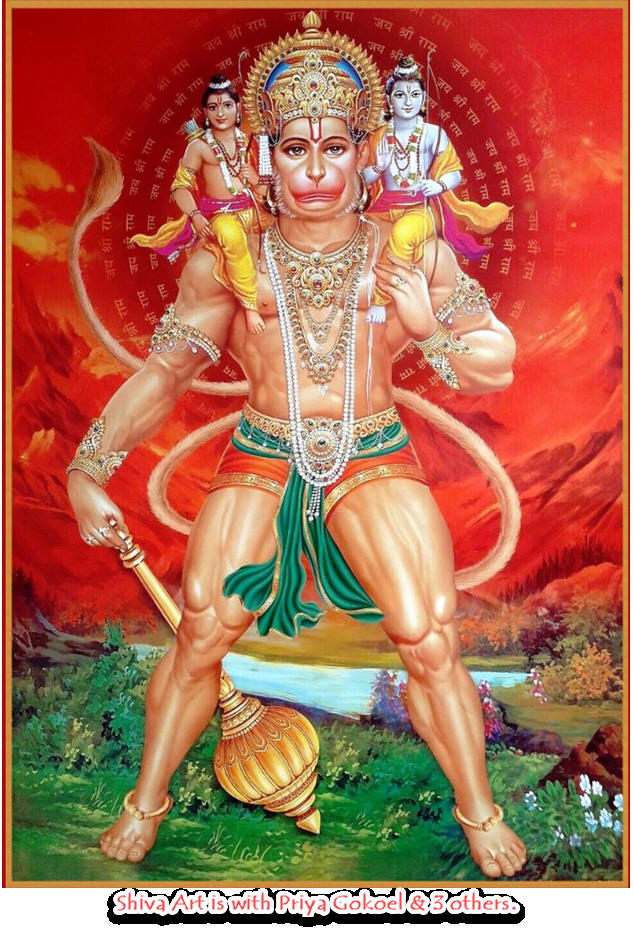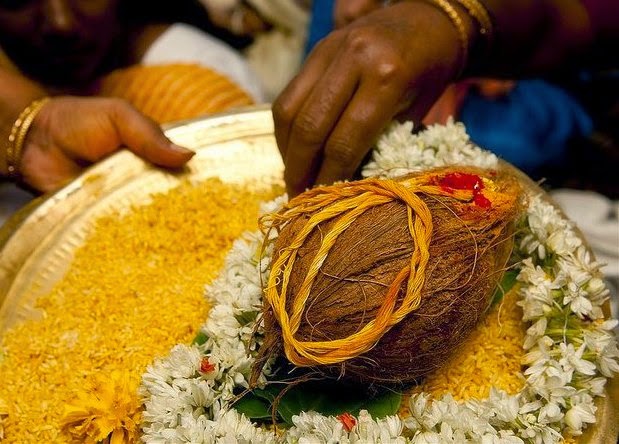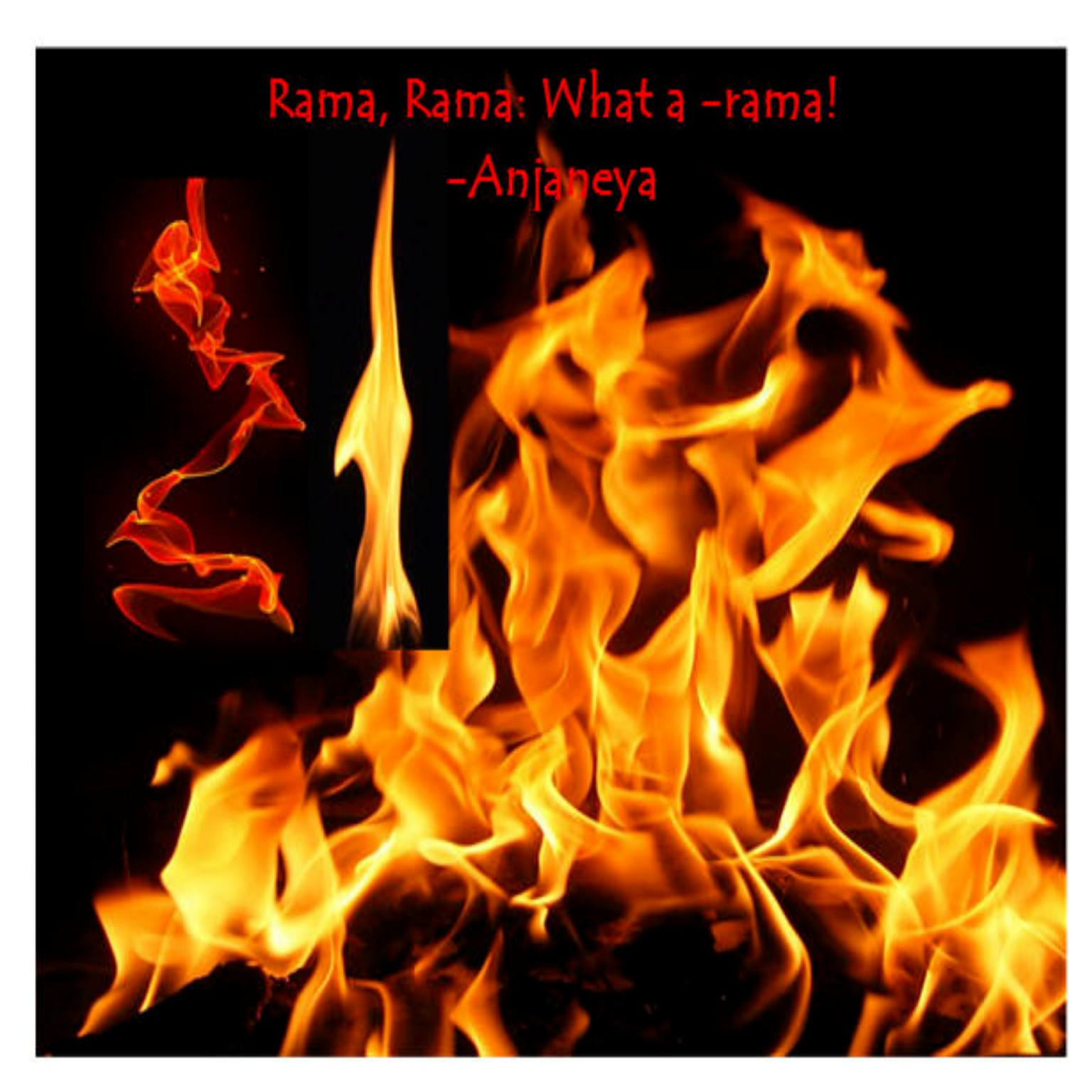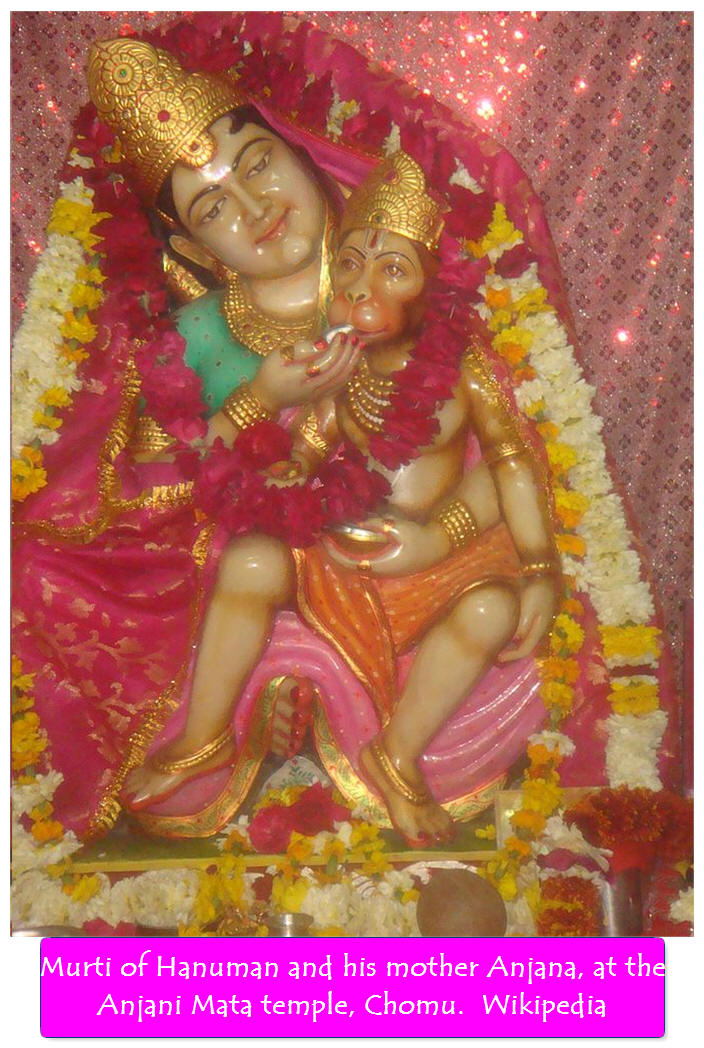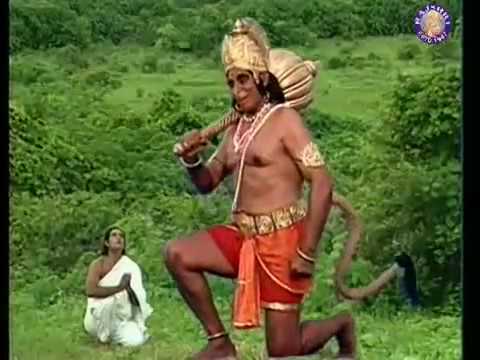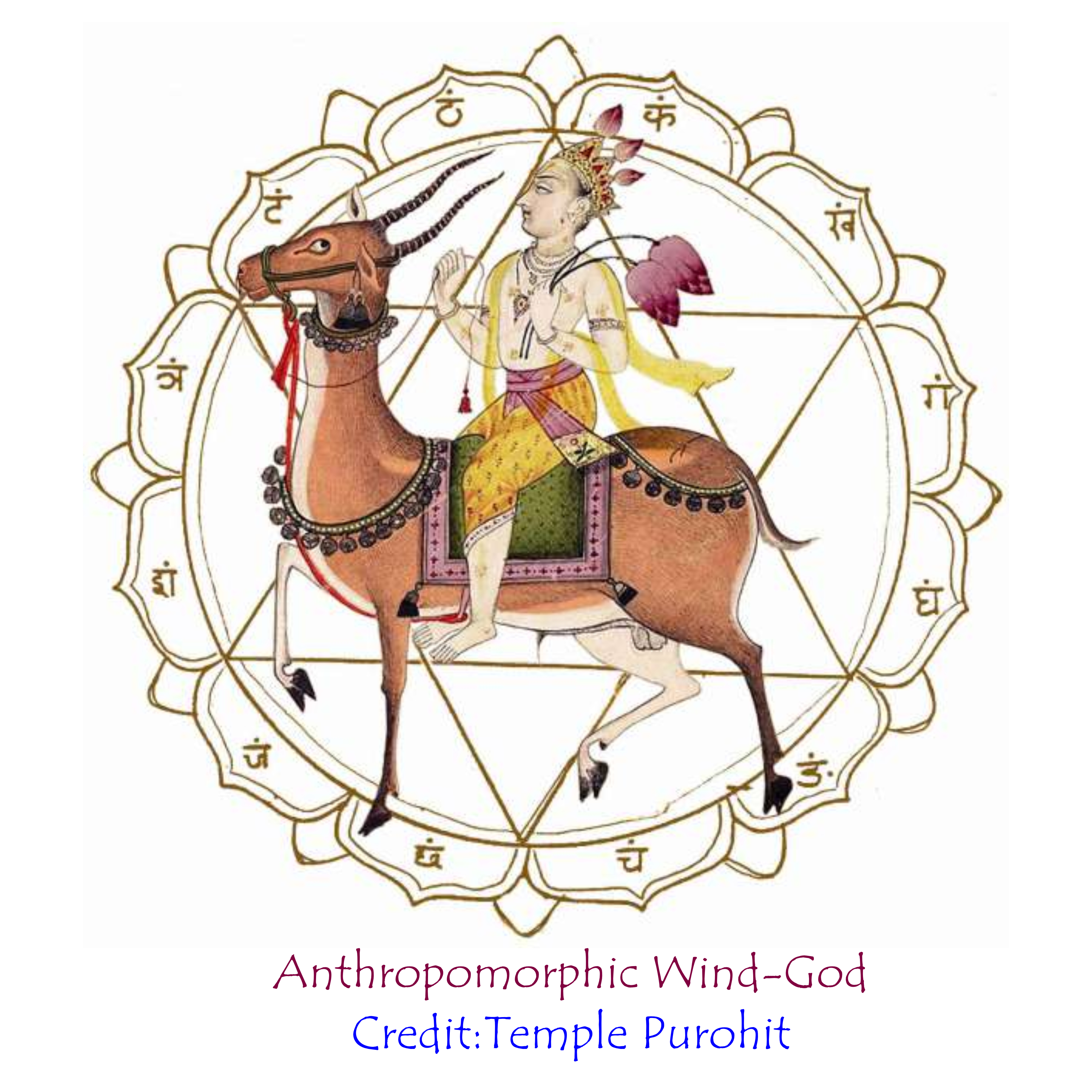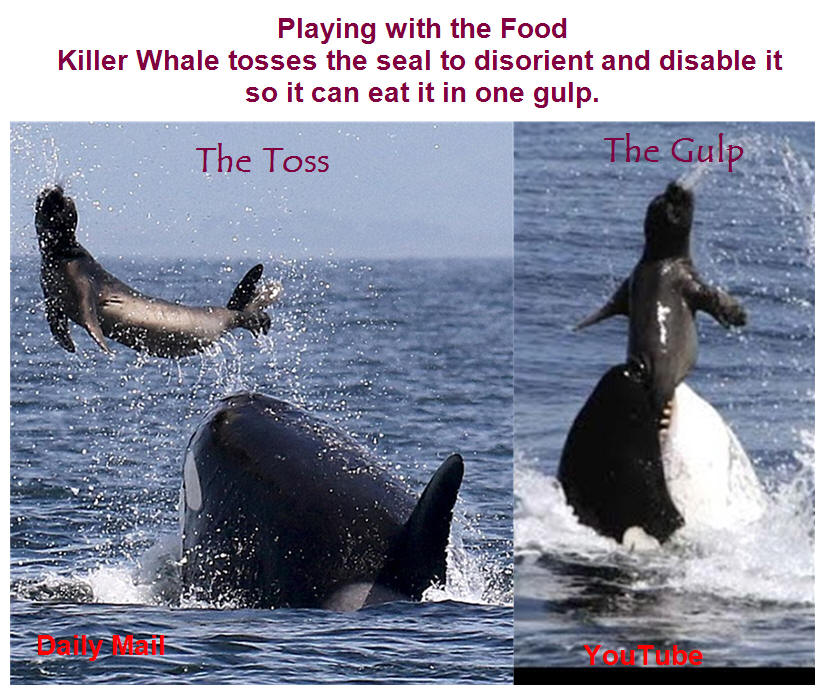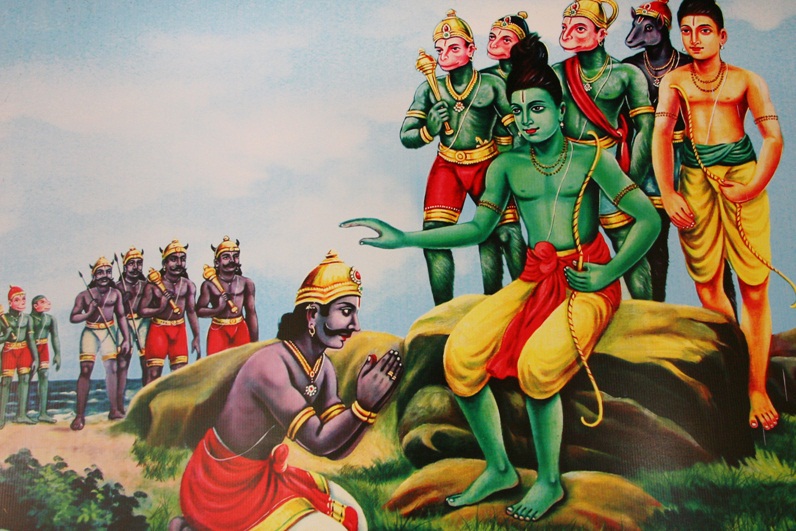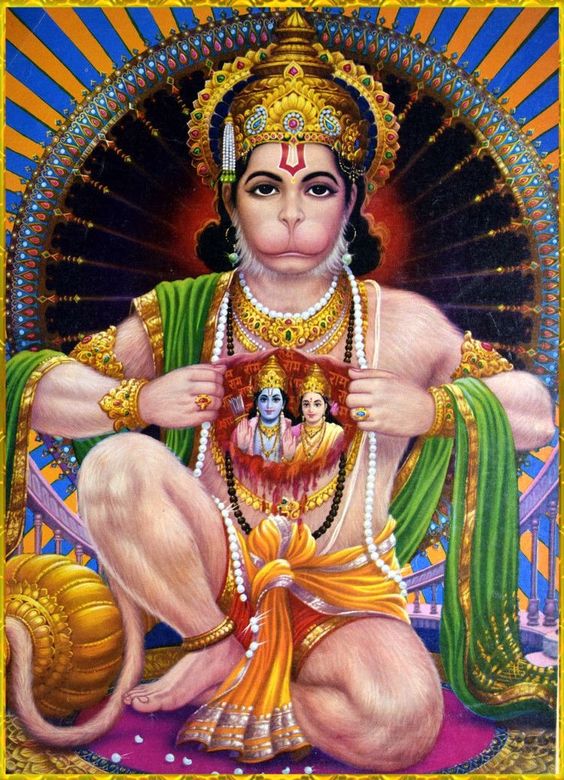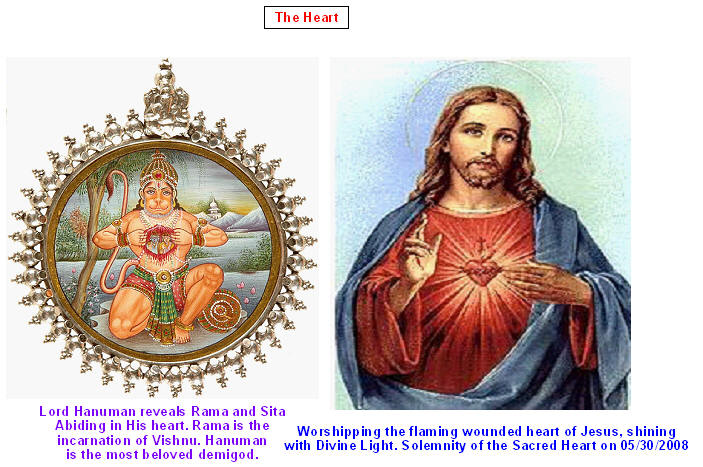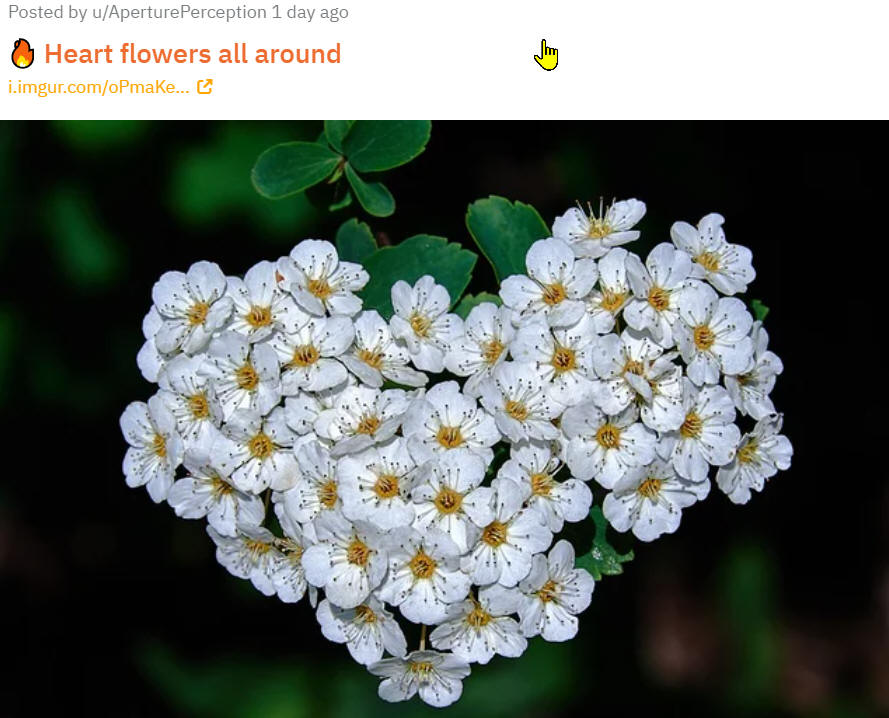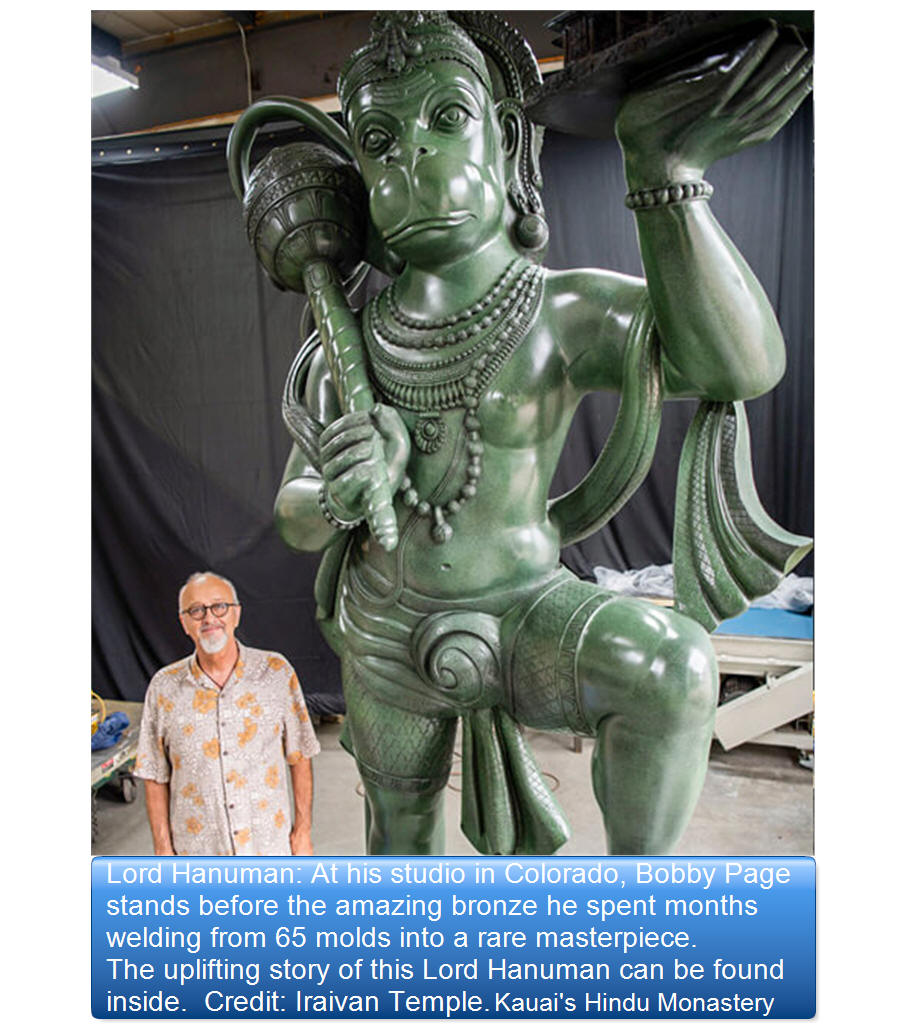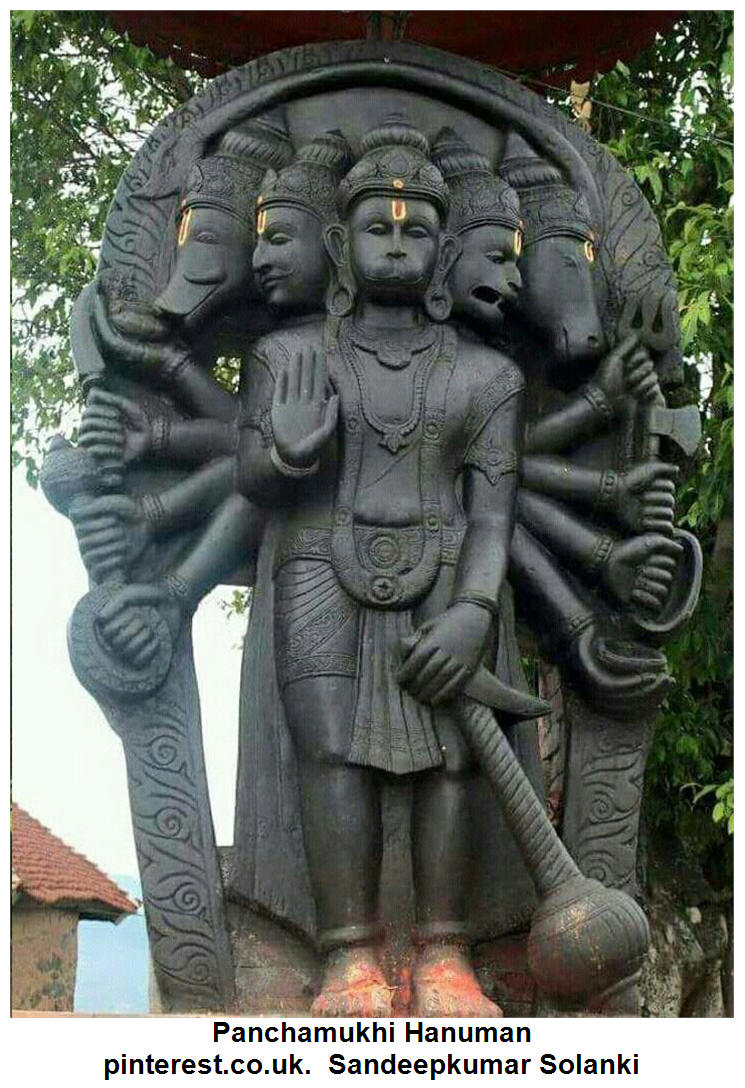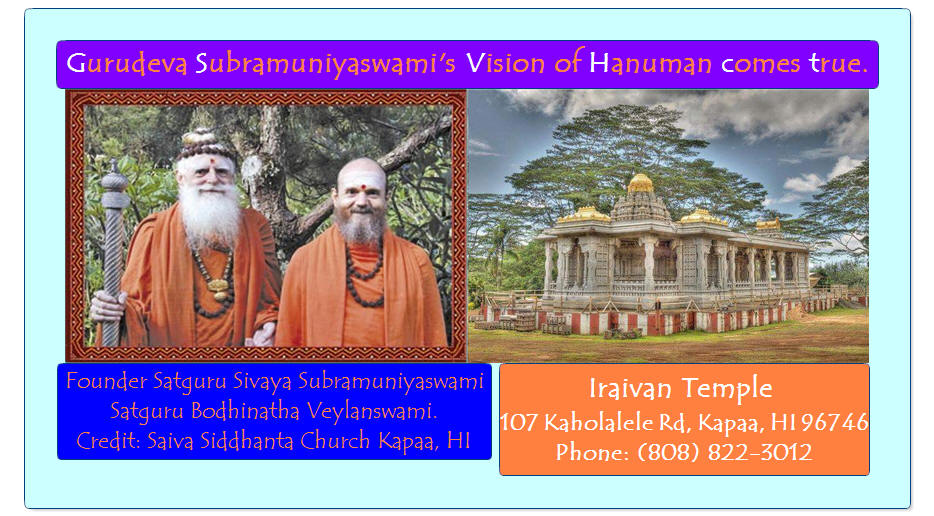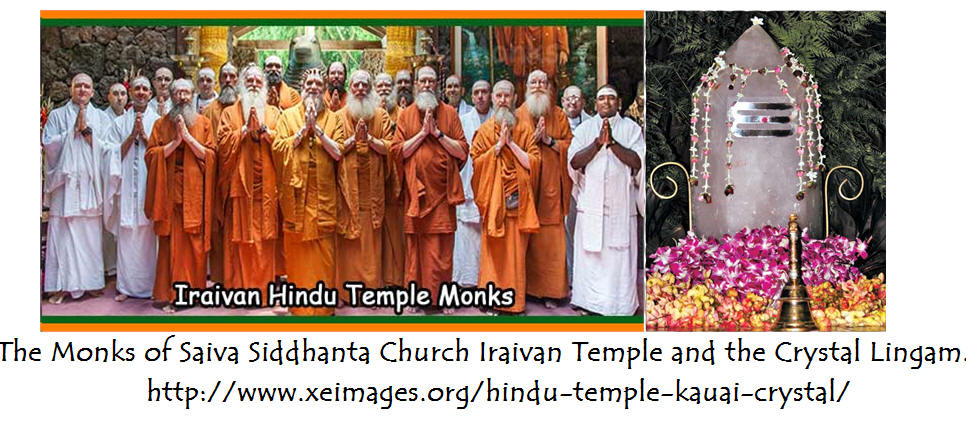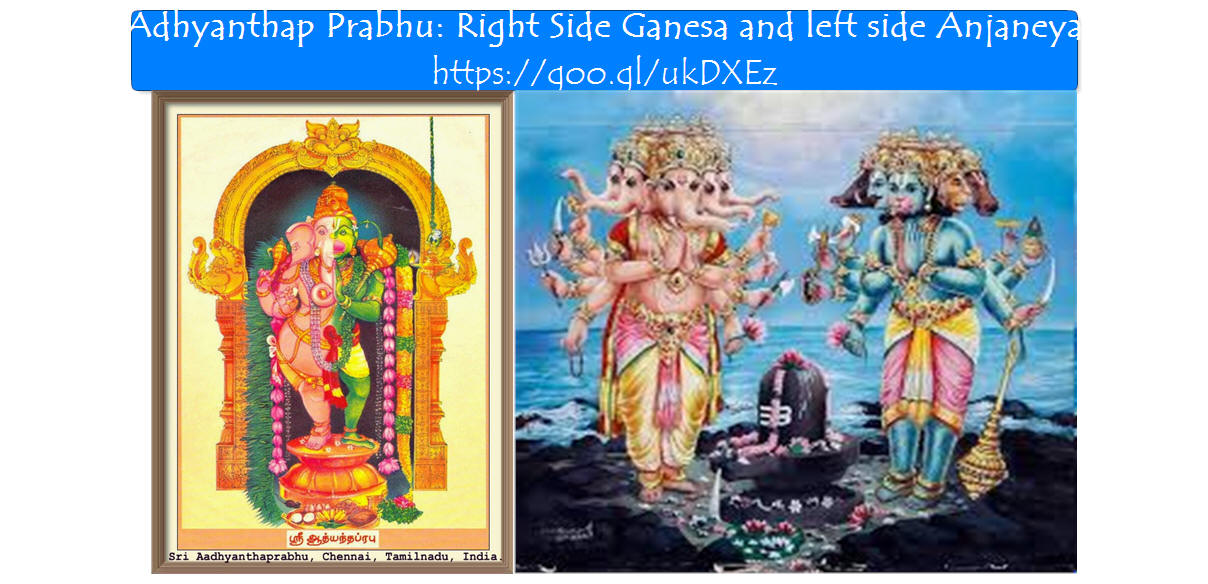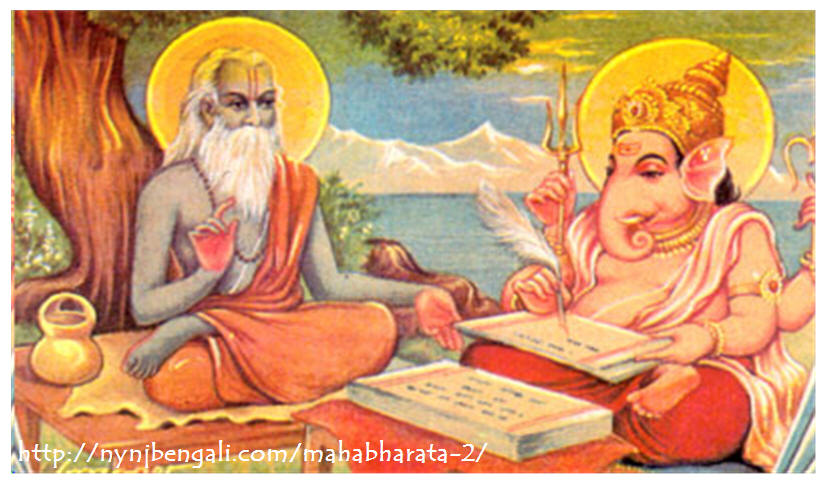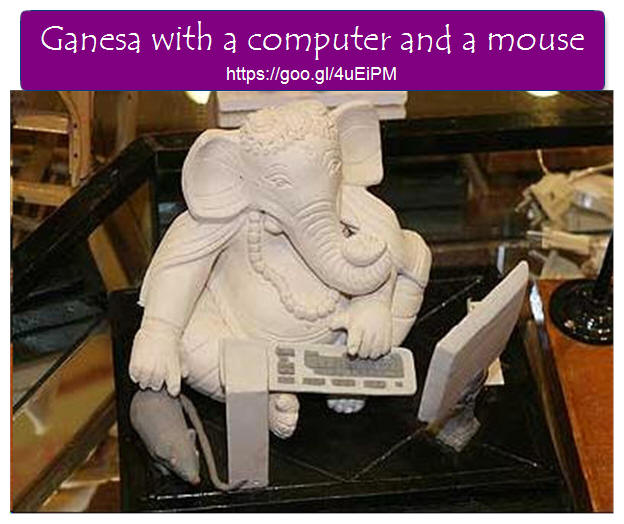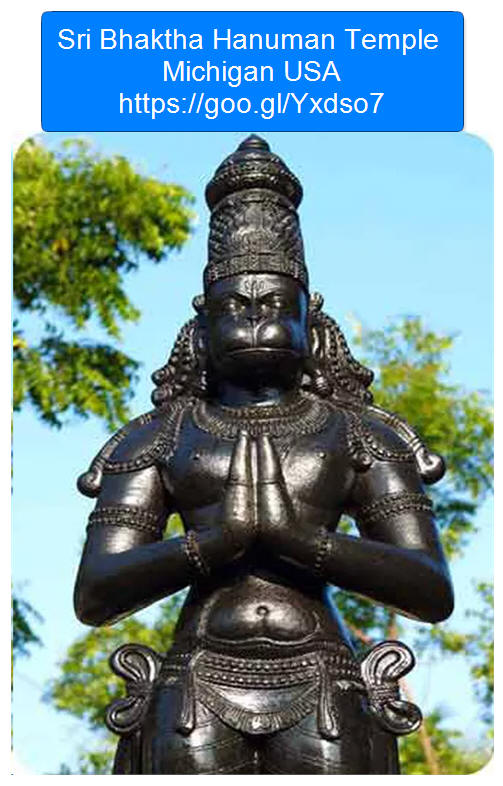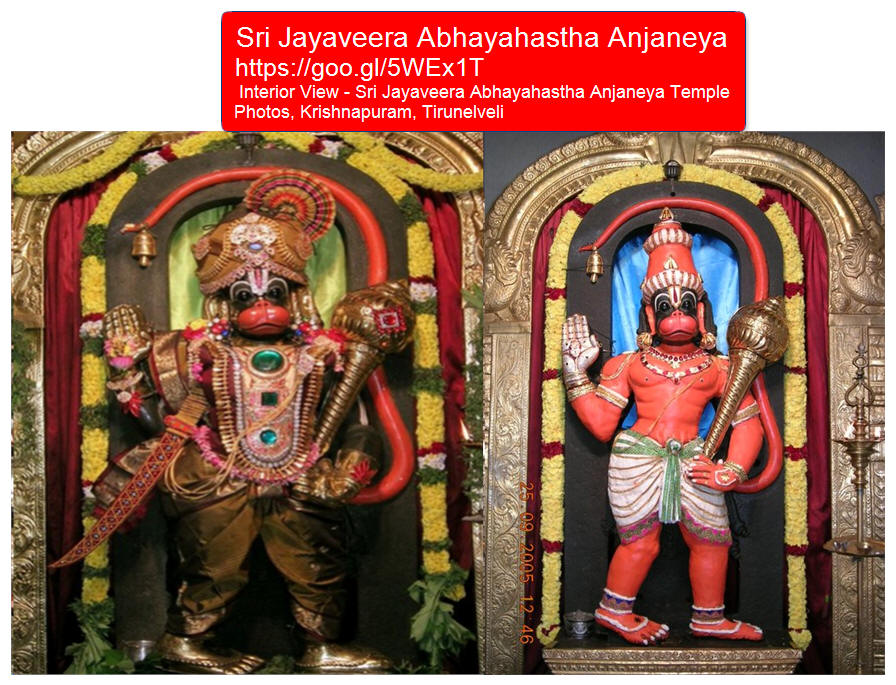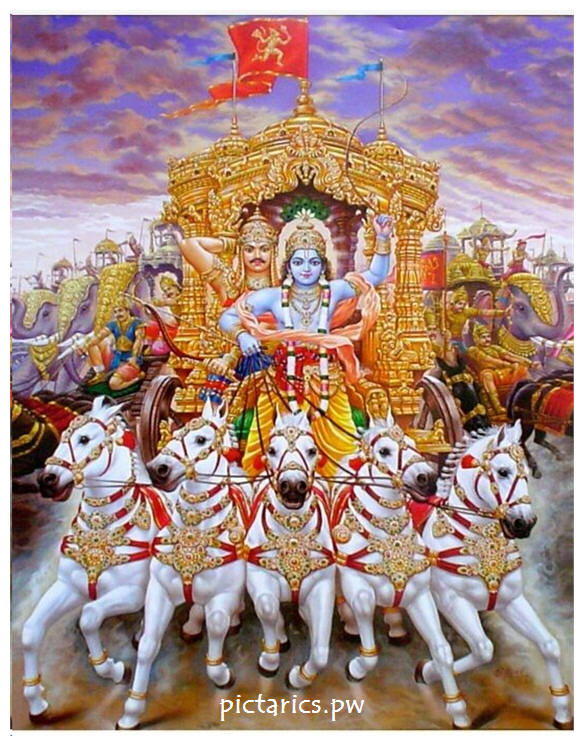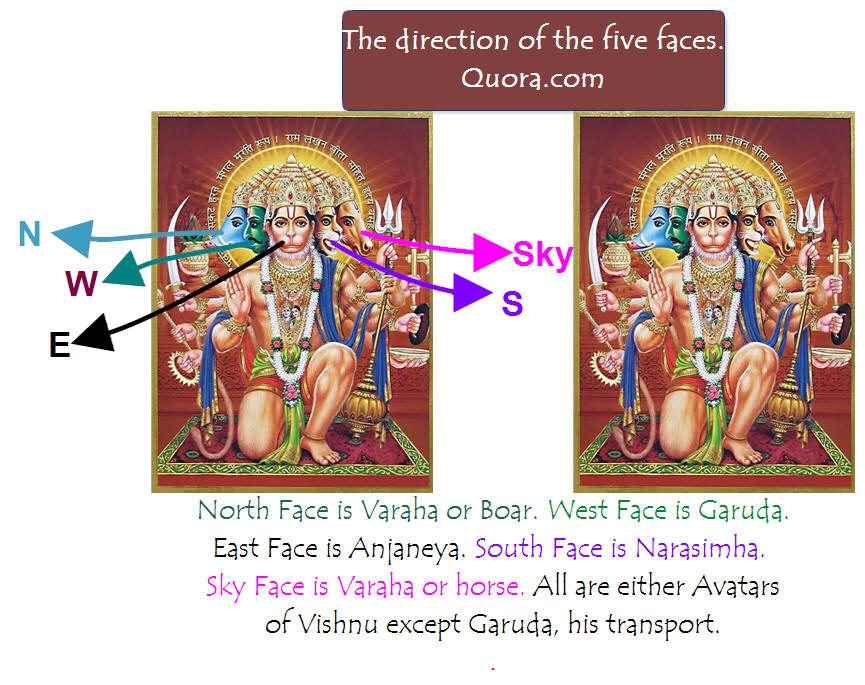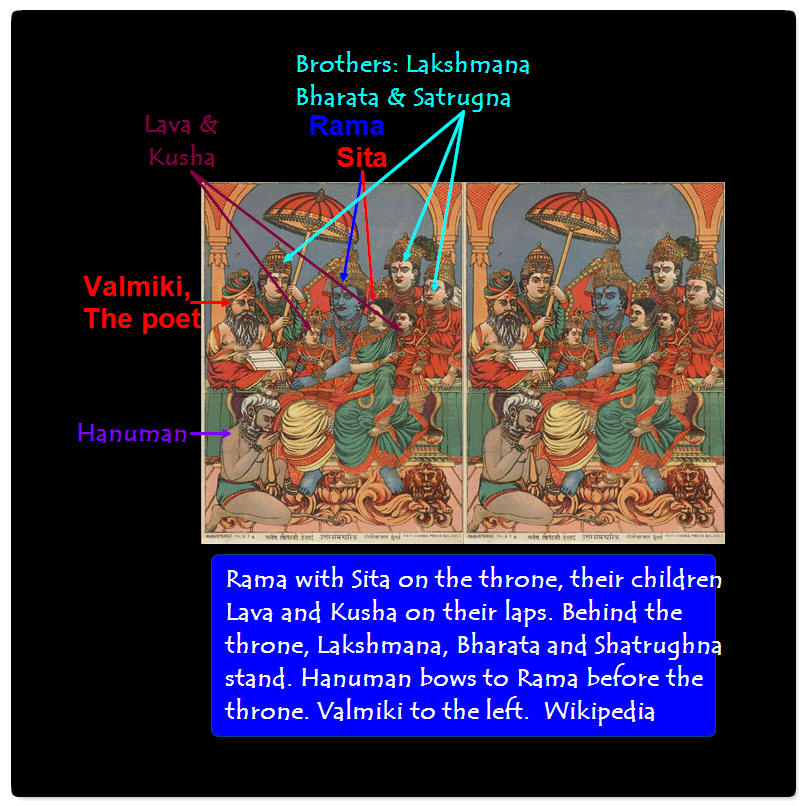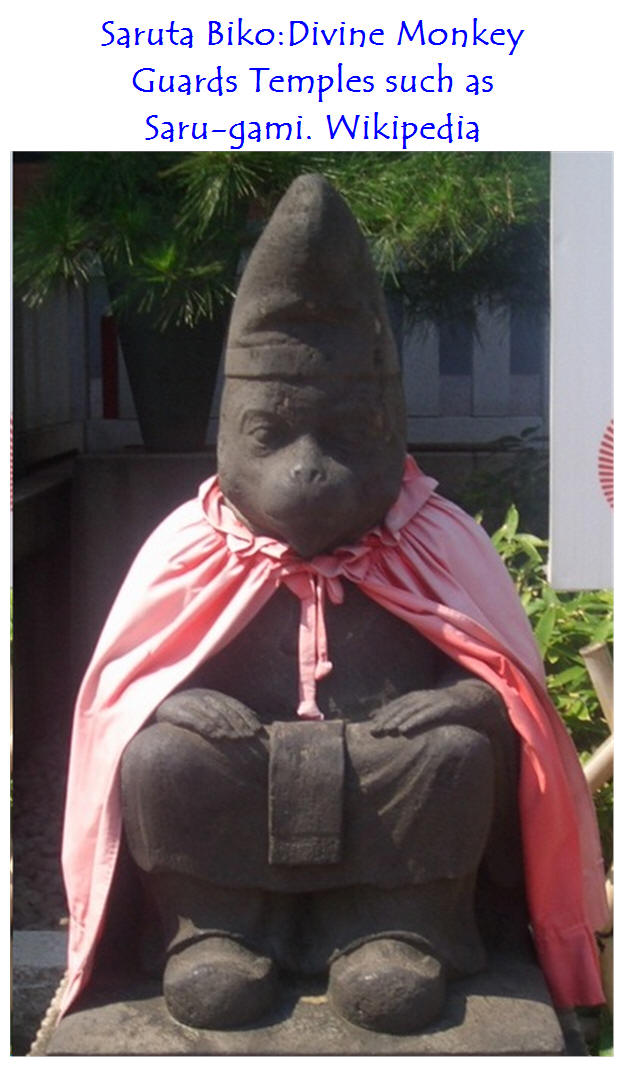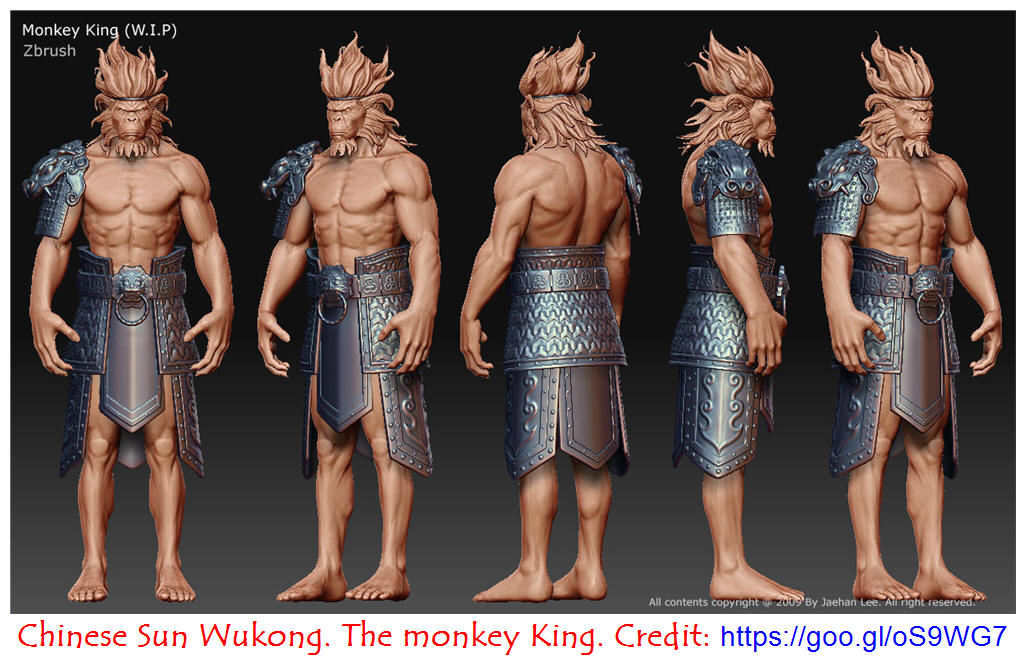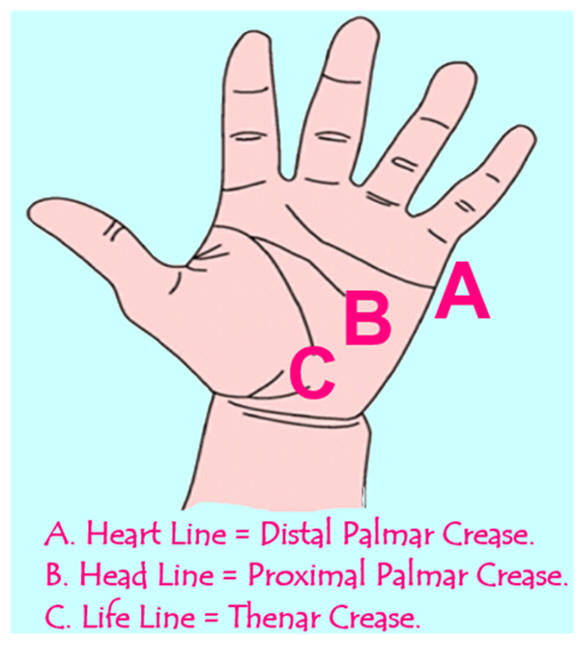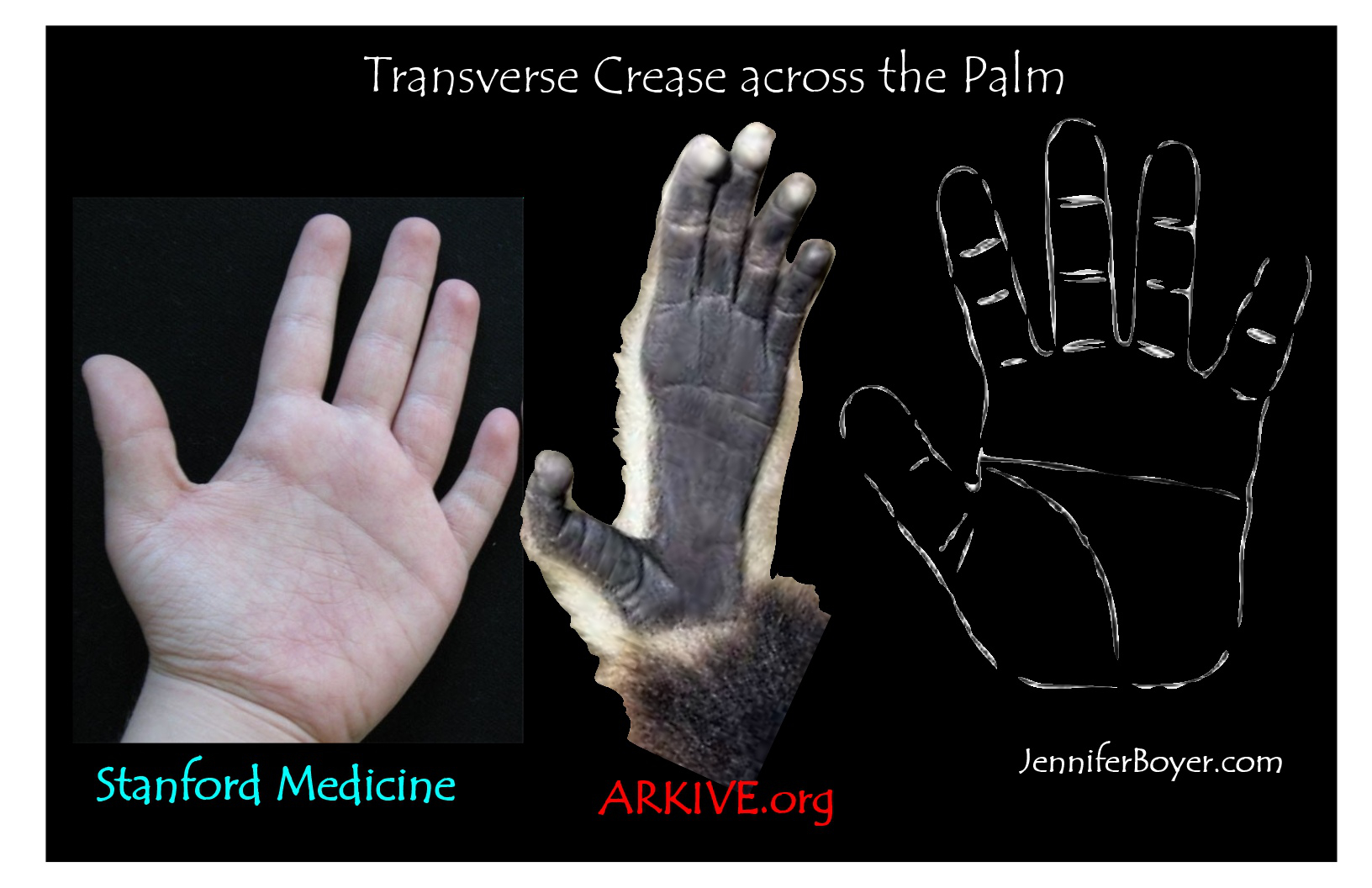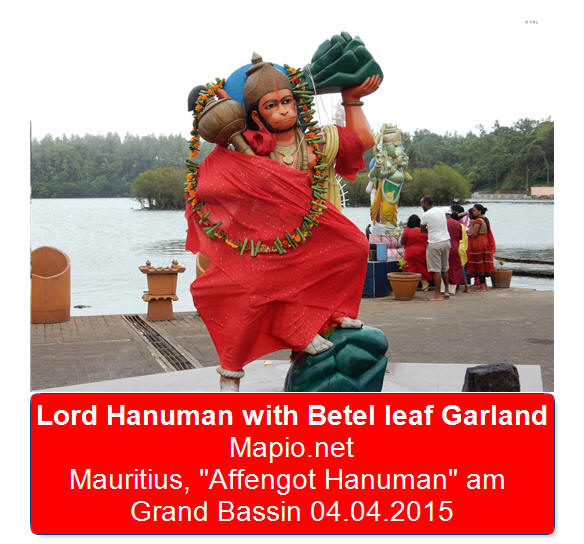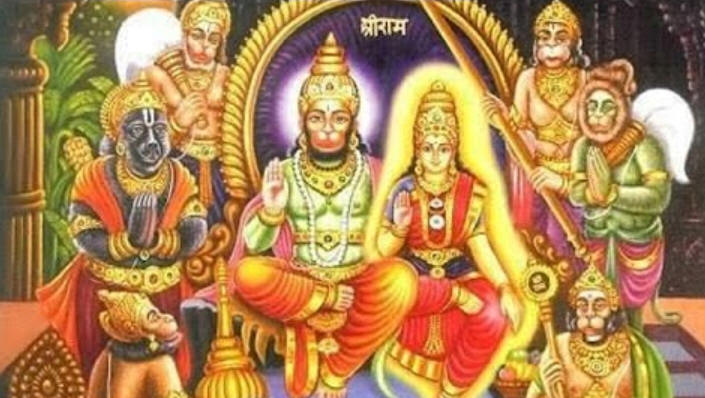வெற்றிலை மாலை
Veeraswamy Krishnaraj
File under construction
Om Sri Hanumate Namah
Last Revision: Jun 29, 2020
Published: Yesterday at 10 PM (Sep 14, 2019) Updated: Yesterday at 10 PM Sakthi Vikatan Ananda Vikatan.
Namakkal Āñjanēyar
1. In the famous Namakkal Āñjanēyar Temple, the statue of Āñjanēyar is 18 feet tall. The temple location is in the western part of the mountain fort, right in the heart of the city of Namakkal. Bakthās come for Darśan from all over the country.
2. Though the priests decorate Āñjanēyar in many styles, they never decorated him with betel leaves. Under these circumstances, a woman devotee from Tiruchi came forward to decorate Āñjanēyar with betel leaves. The betel leaves (108,000) arrived in Namakkal in a refrigerated truck.
3. The Archakars decorated Āñjanēyar yesterday from noon to 1:30 PM. Later Āñjanēyar gave Darśan to the devotees. Thousands of devotees enjoyed the Darśan of Āñjanēyar in Betel-leaf decoration. See the photo below. Credit: Sakthi Vikatan, Anantha Vikatan.
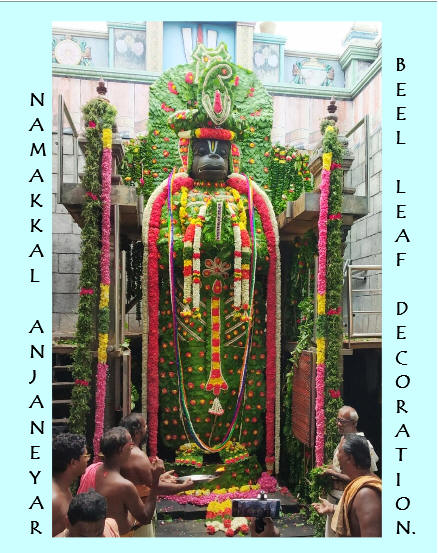
Date of Last Edition of this article: Sep 15, 2019
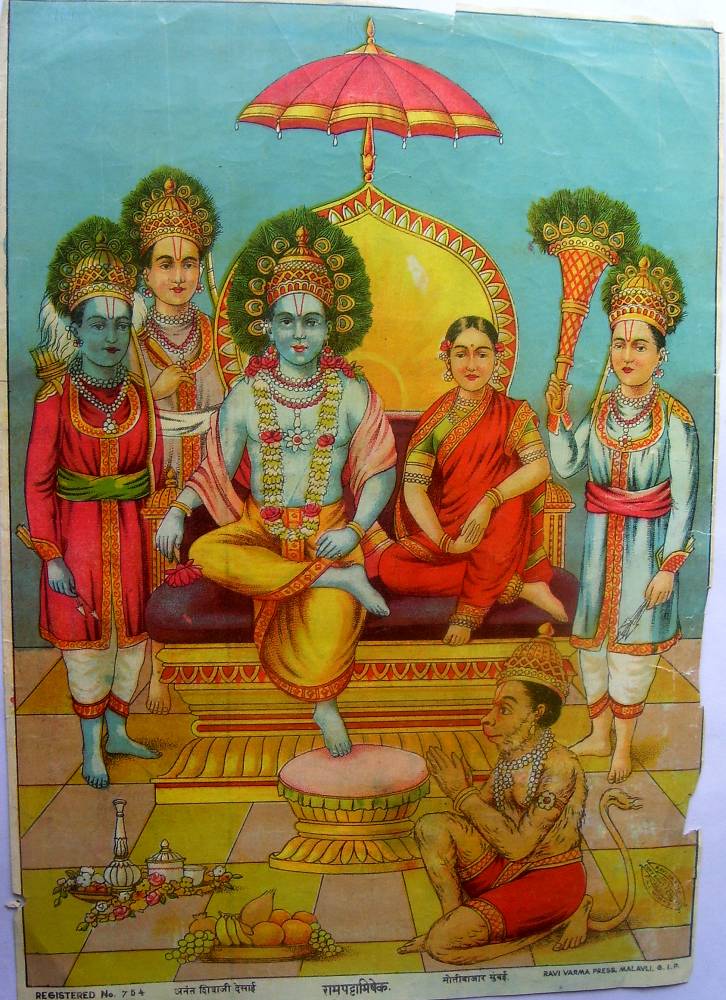
Ram Parivar Painting By Raja Ravi Varma (1848-1906)
Posted on 2019/11/17 11:36:14 ( 90 reads )
Source: hinduismtoday.
When I think of myself as a body, I am your servant, my Lord; when I think of myself as an individual soul, I am part of you; but when I realize I am atman, you and I become one.
-- Lord Hanuman in the epic Ramayana
I introduce the modern genetic concept of Chimeras in the Hindu Pantheon of Gods. Another modern concept for the west, but not to us, is Cloning. Here is a link on Unity of Life: UnityOfLife.html
Hanuman Jayanti celebrations took place in Sri Maha Vallabha Ganapathi Devasthanam on January 4, 2019. This write-up was part of the email I received from the temple, inclusive of the portrait of Lord Hanuman, as seen below
Añjani garbha sambhūta
kapīndra sachivottamam |
Rāmapriya namastubhyam
hanuman rakṣa sarvadā ||
Meaning: I take refuge in Hanumān Who was born from the womb of mother Anjani and who is the most excellent minister of the King of Monkeys (i.e. Sugriva) who is extremely dear to Rāma. I bow to you O Hanumān please protect me always.
Sri Hanumān is identified as Rāma Dūta (emissary). Śri Hanuman’s strength flowed from his intense faith and devotion to Śri Rāma on Whose name He was constantly meditating. It was no wonder that Brahmajñāna or knowledge of the Supreme was revealed to Sri Hanumān by Rāma Himself. The Sundara Kānda, which is the most auspicious and widely read section of epic Rāmāyanā, is filled with His intelligent, thoughtful, brave, courageous, inspiring and confidence-building deeds. He humbly wished to remain as Rāma Dāsā (Sri Rāmā's servant), and was blessed to be a Chiranjīvi (immortal).
Śri Hanumān is also known as Śri Ānjaneya (Anjana’s son) and is believed to be still living among us, helping us in mystical ways. Like lord Ganeśa, Hanumān, is also believed to be not afflicted by Śri Śanaischara (Saturn). It is therefore customary to pray to Hanumān to nullify or diminish the
ill-effects of Saturn. Hanumān is said to have rescued Śri Śanaischara from the clutches of Rāvana. In gratitude, Śri Śanaischara promised to protect Sri Hanumān’s devotees. A rational explanation for this belief could be that when we pray to Sri Hanumān, He would nullify our karma resulting from our selfish acts, by inspiring us to devote our lives in humble selfless service.
Tulsidās composed the vastly popular Hanumān Chālisā (40 verses on Hanumān). Chanting the Hanumān Chālisā ( See below) is a popular way of expressing our devotion to Lord Hanumān. Every year, The Hindu Temple Society of North America (Śri Mahā Vallabha Ganapathi Devasthānam), organizes a eleven-day chanting of Chālisā eleven times a day, beginning from ten days before Hanumān Jayanti (birthday) and culminating With His Jayanti.
On the occasion of Sri Jayanti, may all pray to Sri Hanumān and receive His Blessings for happiness and success in all our endeavors.
Om Rāma dhūtāya vidhmahē Vāyuputrāya dhīmahi|
Tannō Hanumat prachodayāt||
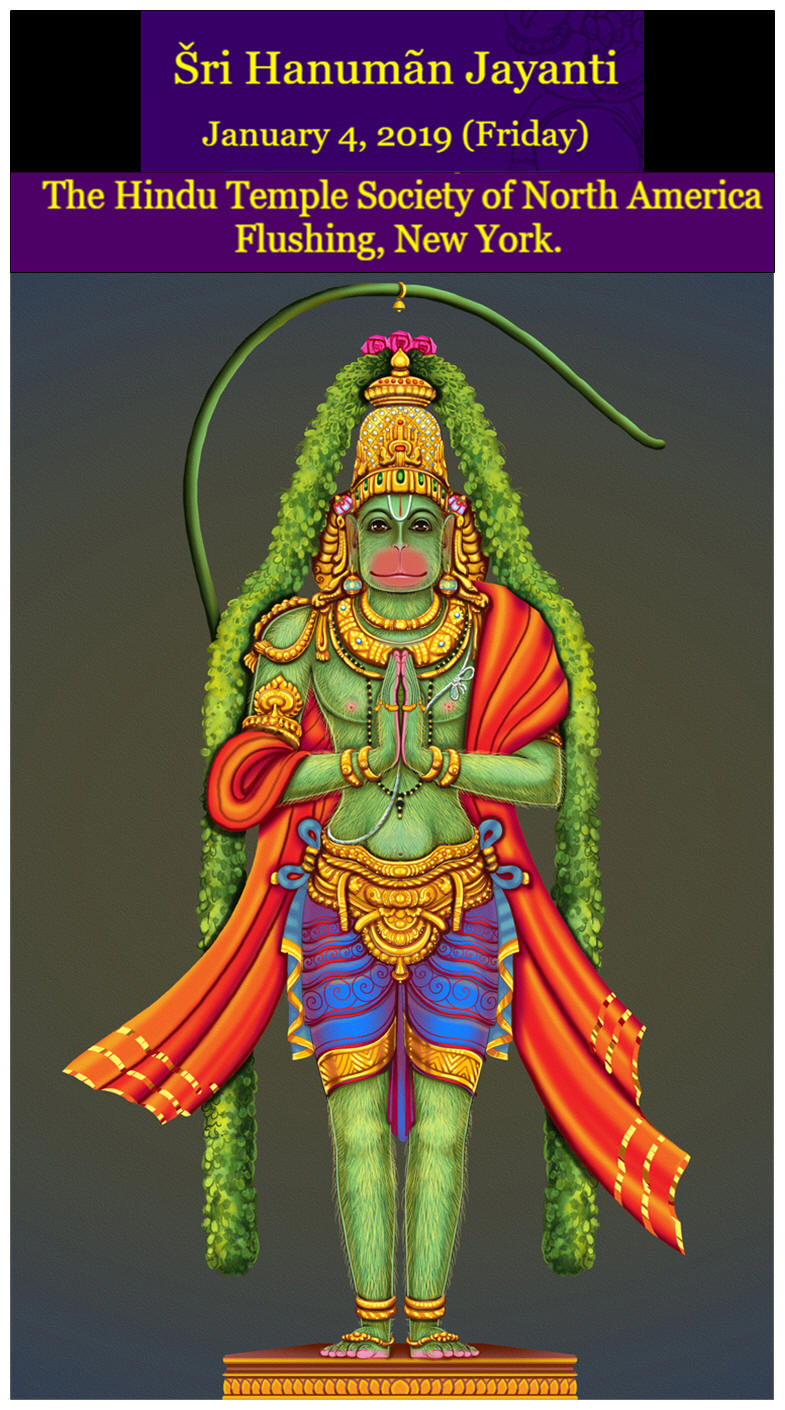
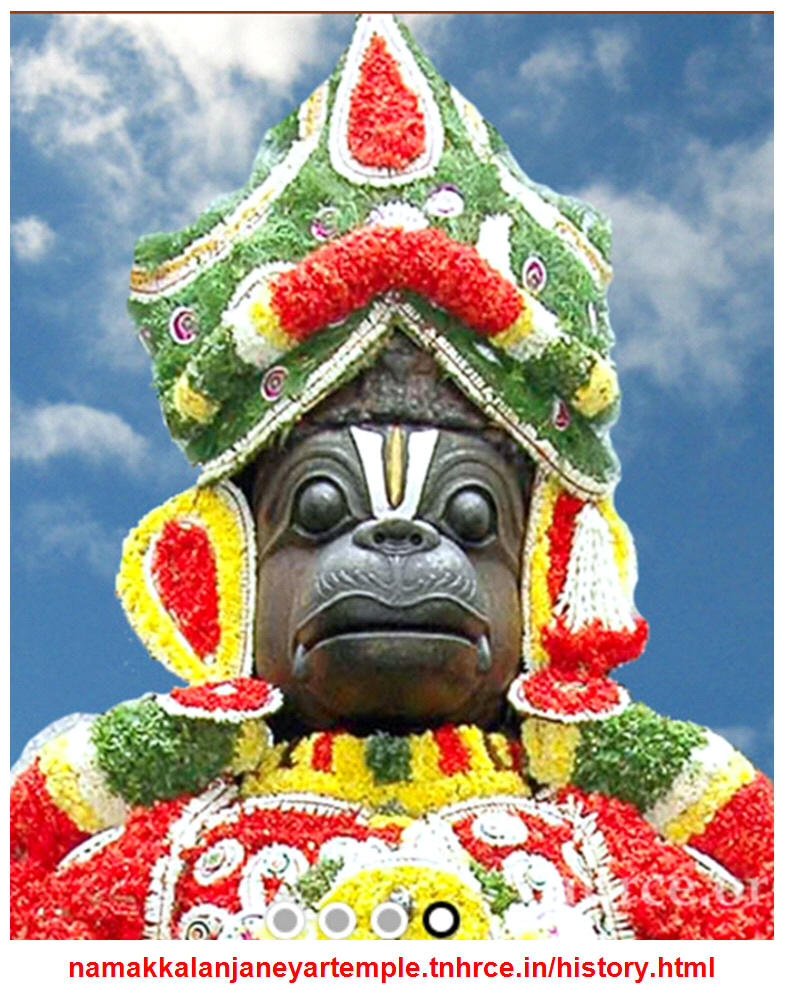
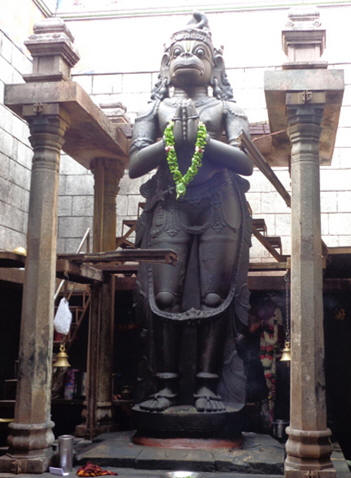
Digambara Anjaneyar. Namakkal
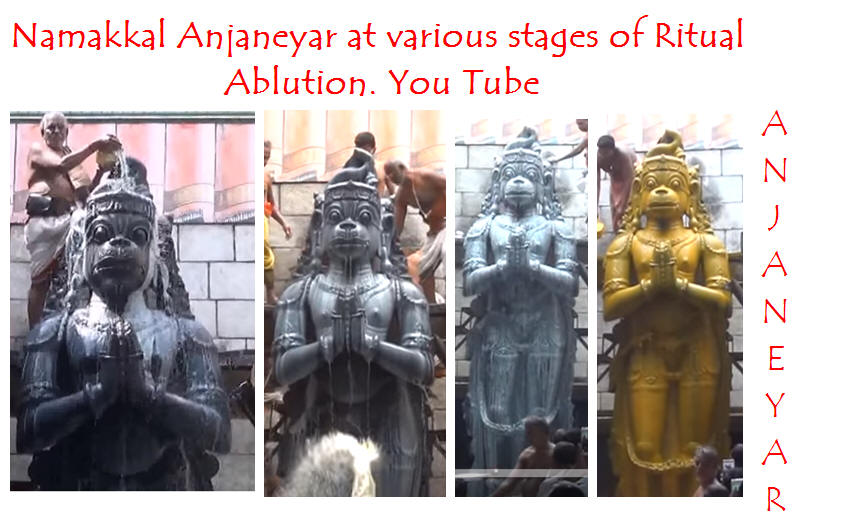


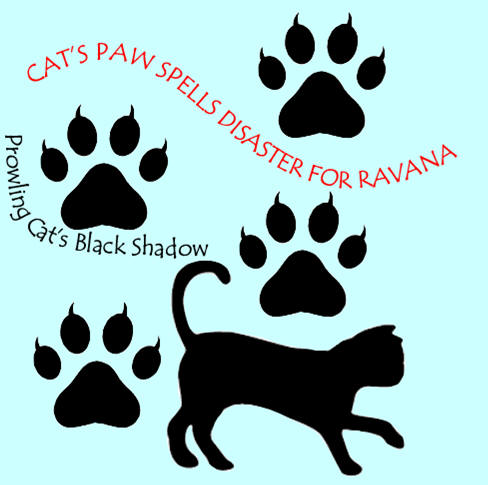
Anjaneya had Yogic attribute: Shapeshifting, the ability to change the physical form and size at will.
He shapeshifted to a cat ("long-haired silver Tabby Cat"), entered Sri Lanka and searched for Sita unseen and unknown to anyone (human). Surasa the mother of Nagas and Simhika, the daughter of Diti tried to impede his jump. He defeated them. Siva and Parvati the protectors of Sri Lanka, left as soon as Hanuman in his search of Sita entered Sri Lanka. That is the beginning of trouble for Ravana thus far protected by Siva and Parvati. Hanuman took the size and shape of a cat and entered the palace of Ravana and did not find Sita there. He met Vibhishana, brother of Ravana and a friend of Rama, who directed him to Ashoka garden. Hanuman took his original native form. Anjaneya was the biological son of Siva and beneficiary of the power of Sakti of Parvati. When the Guardians left Sri Lanka, they were siding with Anjaneya and did not want any conflicts with Pavanputra, Siva's son (Pavan Putra = Siva's son. Pavan has two meanings: Siva or Wind.) and Rama himself. Pavan Putra or Anjaneya found Sita in the Asoka forest. Yes, there was a woman of divine nature with sallow complexion surrounded by Raksasis (Ogresses). Hanuman appeared before Sita, who thought he was Ravana in disguise. Ravana appeared before Sita in the guise of a Sanyasin in Janasthana back in the hermitage in India. Sita said to Hanuman, "Why do you appear before me now as a monkey?" Then Rama's signet ring in the hands of Hanuman appeared before the eyes of Sita, who was convinced Hanuman was Rama's friend and emissary.
Note: Sita spoke to Hanuman in the Dravidian tongue: Tamil. --Purnalingam Pillai, a well-known Tamil Scholar and author. Yes, Sita was a polyglot. In India, Sanskrit and Tamil are the Classical Languages. Tamil has the unique status that it is a living language of the Tamils from time immemorial.
Anjaneya introduced himself with bent knee and opposed palms, and narrated the story of Rama and Lakshmana since her abduction. He gave the Rama's signet ring to Sita to prove that he was sent by him in search of her. Sita saw the Signet ring engraved with 'Rama, Rama, Rama.' That was the ring her father gave to Rama. She in turn gave her own hair-jewel to give to Rama. Sita was grateful to Anjaneya and wanted to offer a gift to him. (Hanuman took back the Signet ring of Rama and held the hair-jewel of Sita for presentation to Rama.)
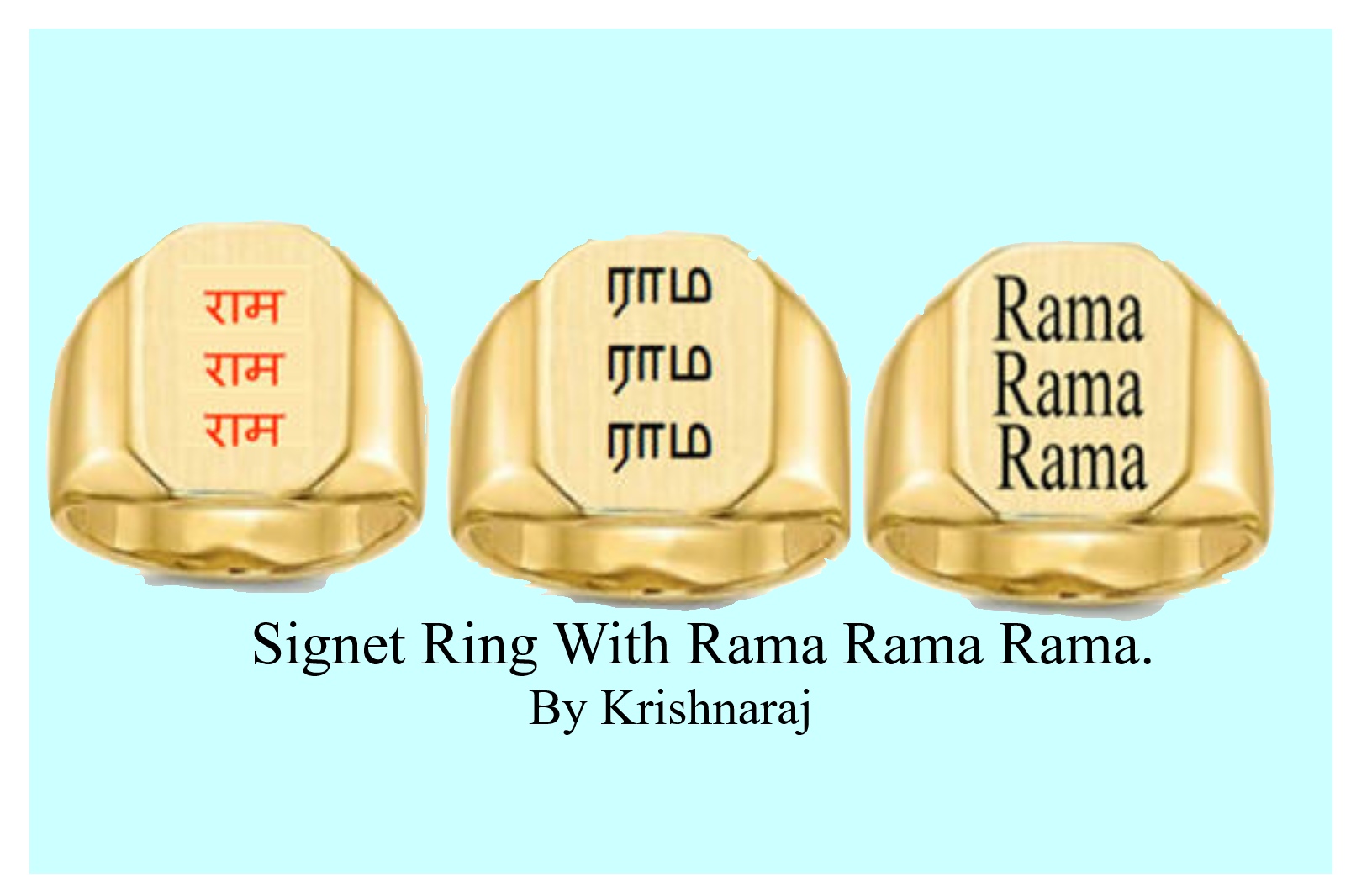
akṣata. Unbroken grains of rice.
அட்சதை aṭcatai , n. < a-kṣata. 1. Unbroken grains of rice mixed with turmeric or saffron, used in benediction, worship, wedding...
Credit: https://goo.gl/ARrcaq
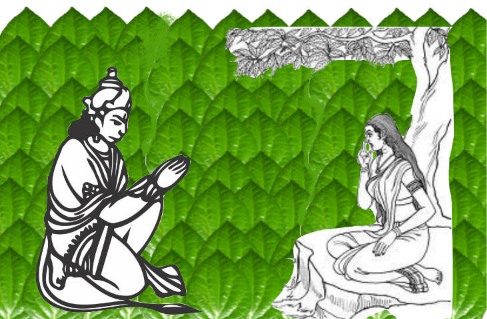

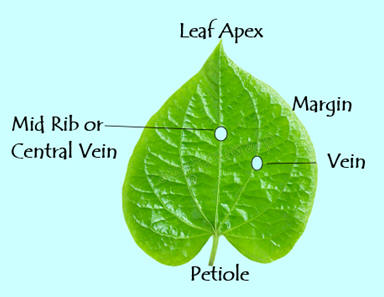
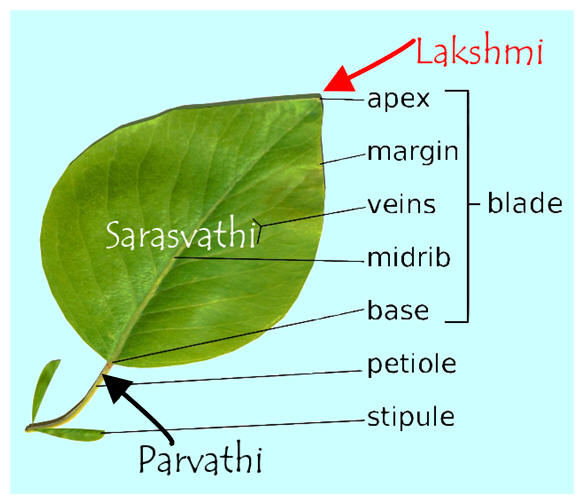
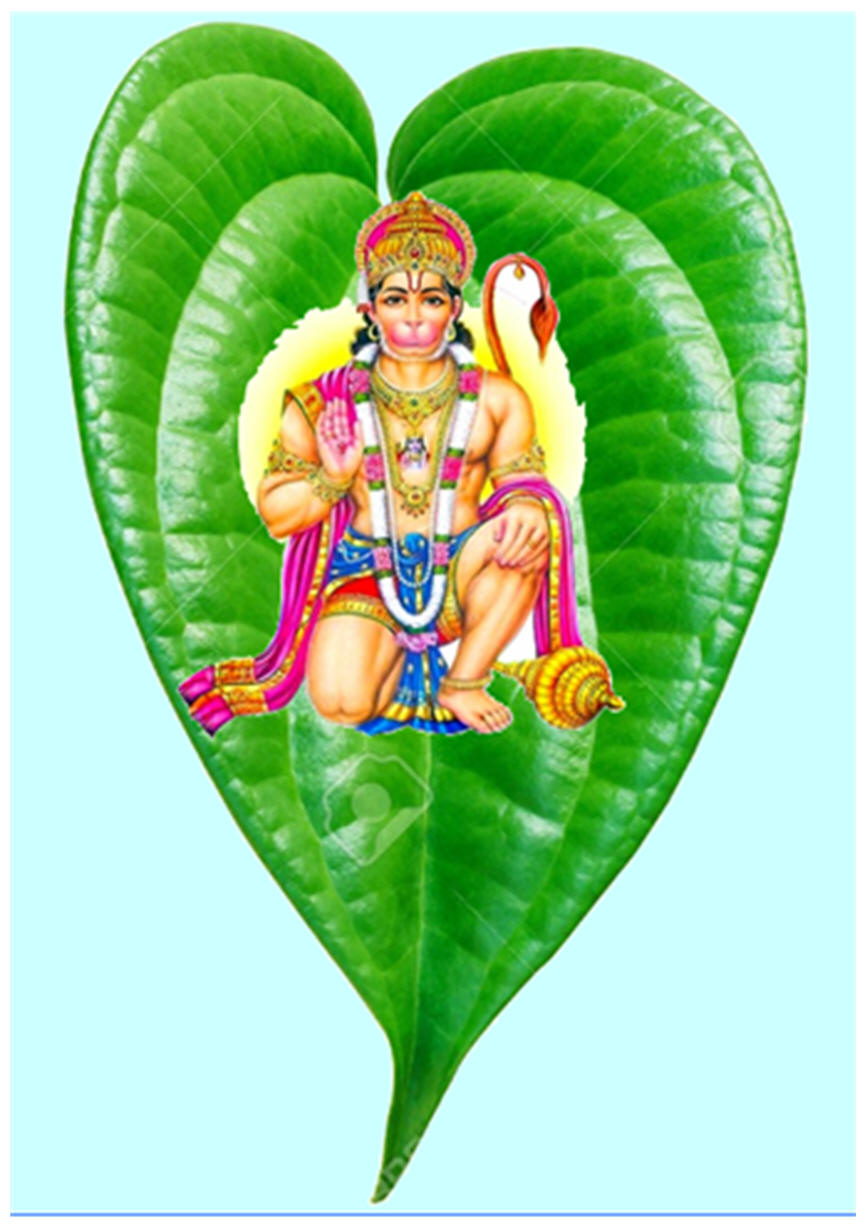
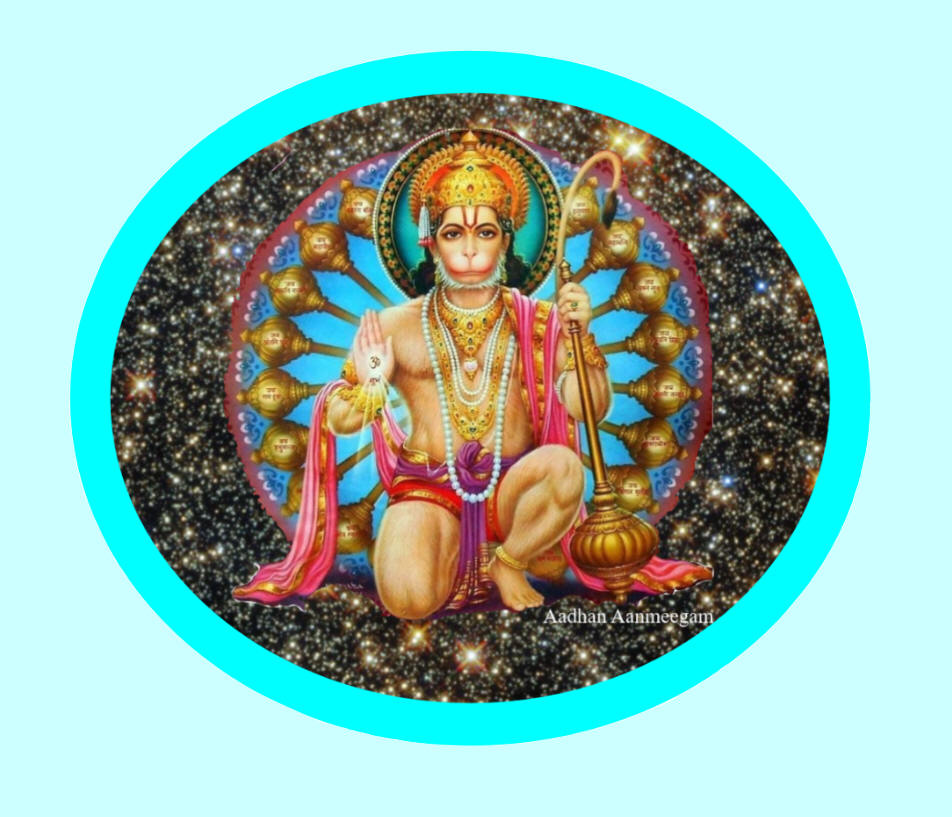
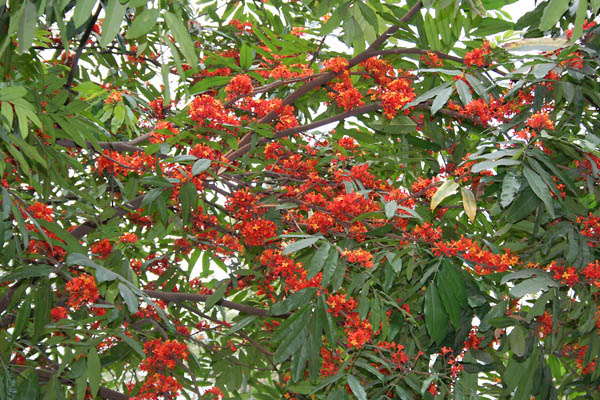
Asoka tree flowers and leaves
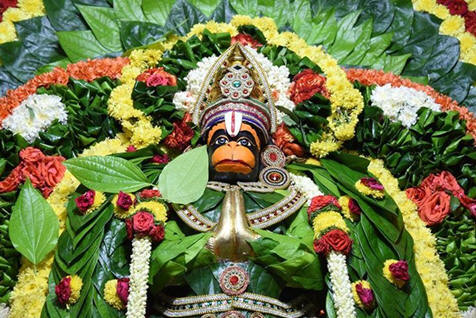
Here is a Betel Leaf Decoration of Hanuman. This kind of decoration is used for other deities also. Credit Sakti Vikatan
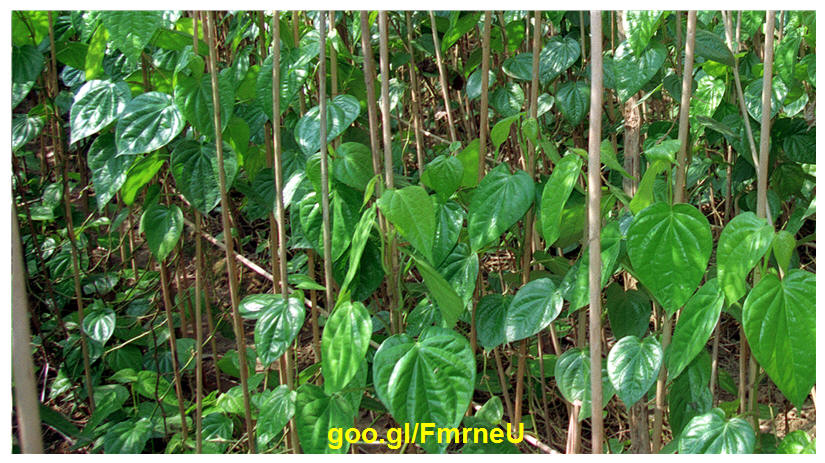
This is an example of Betel leaf farm for commerical cultivation.
Betel Leaf Swirl displayed in shops
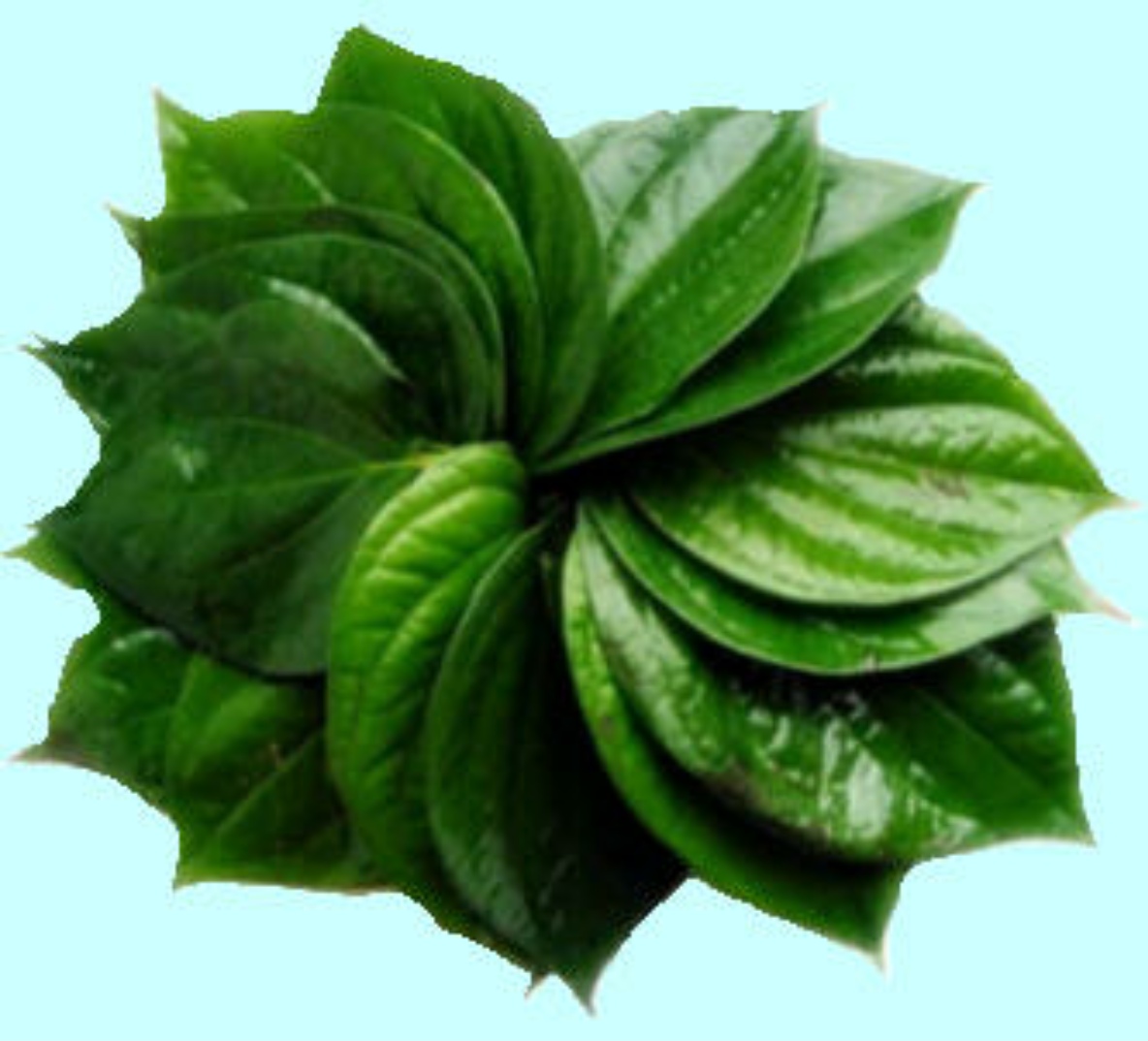
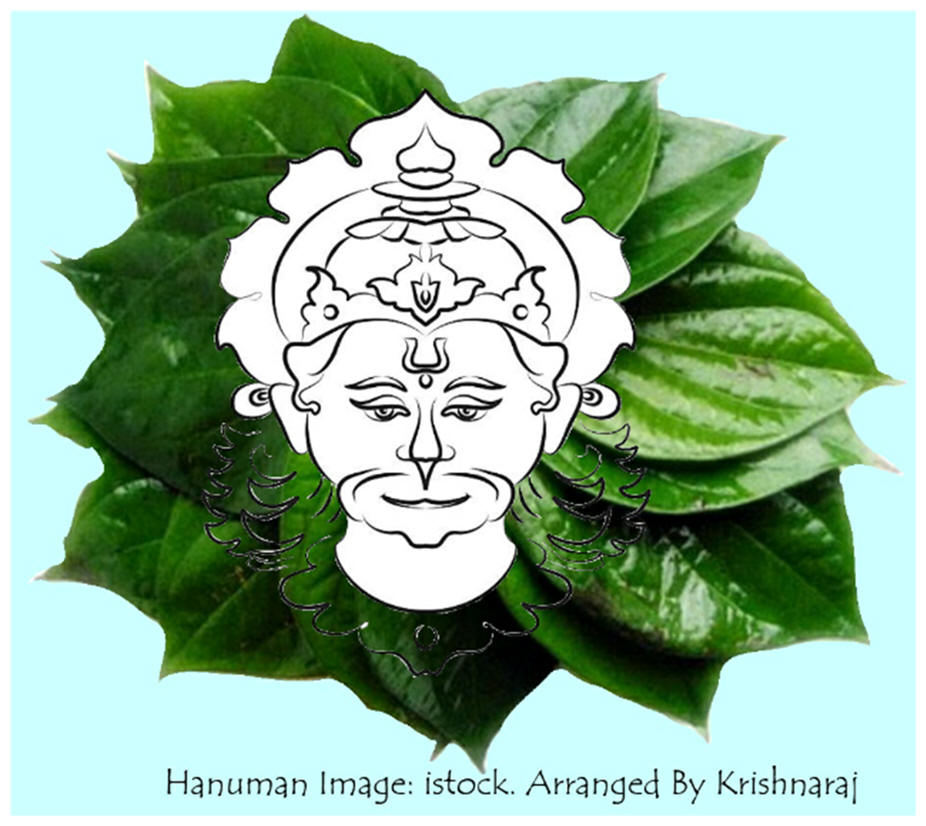
-------------------------------------------------------------------------------------------------------------------------------------------------------------
Wreaths images: Arranged by V. Krishnaraj

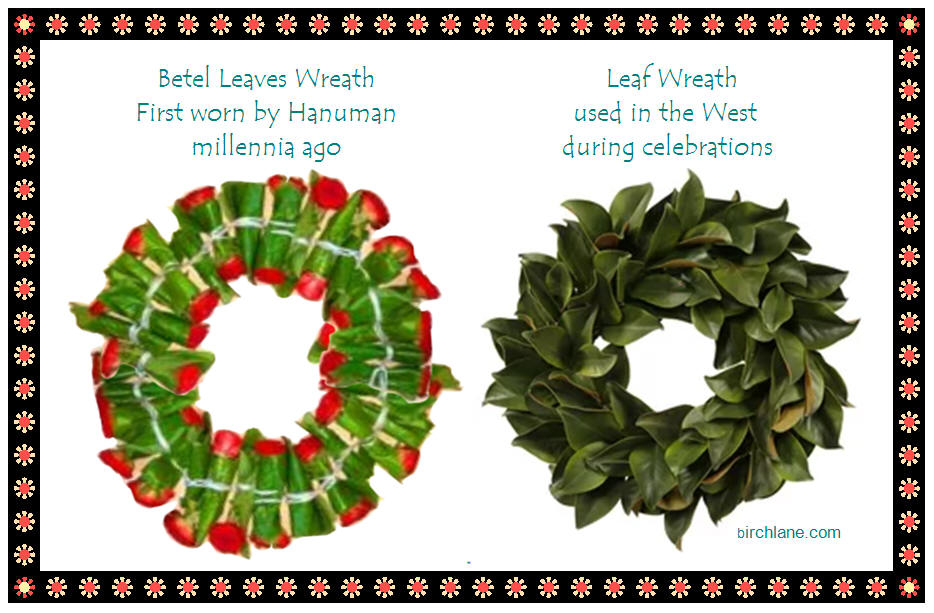
Betel leaf garland Vs. Christmas and Other Wreaths worn in the West.
A Wreath is a deft construction of a circle made of flowers, fruits, and leaves. It is an Advent, and Christmas decoration hung on the doors. You can wear it on the head and call it Chaplet (meaning victory or authority).
Its green leaves represent strength. The Greeks wore the floral circle on the head projecting their high status. Laurel wreaths graced the heads of winning athletes. Italian college graduates wear the eco-friendly floral wreaths for the graduation ceremony. Hindu gods wear betel leaves. Greek gods like Zeus wear oak leaves. In ancient Olympic games, the athletes wore olive leaf wreaths.
November 4, 2018
Winners Mary Keitany of Kenya, left, and Lelisa Desisa of Ethiopia pose with their medals (and Leaf Wreaths) during the 2018 TCS New York City Marathon in New York on November 4, 2018. - CNN USA . NYC Marathon Sponsored by Tata Consultancy Services.
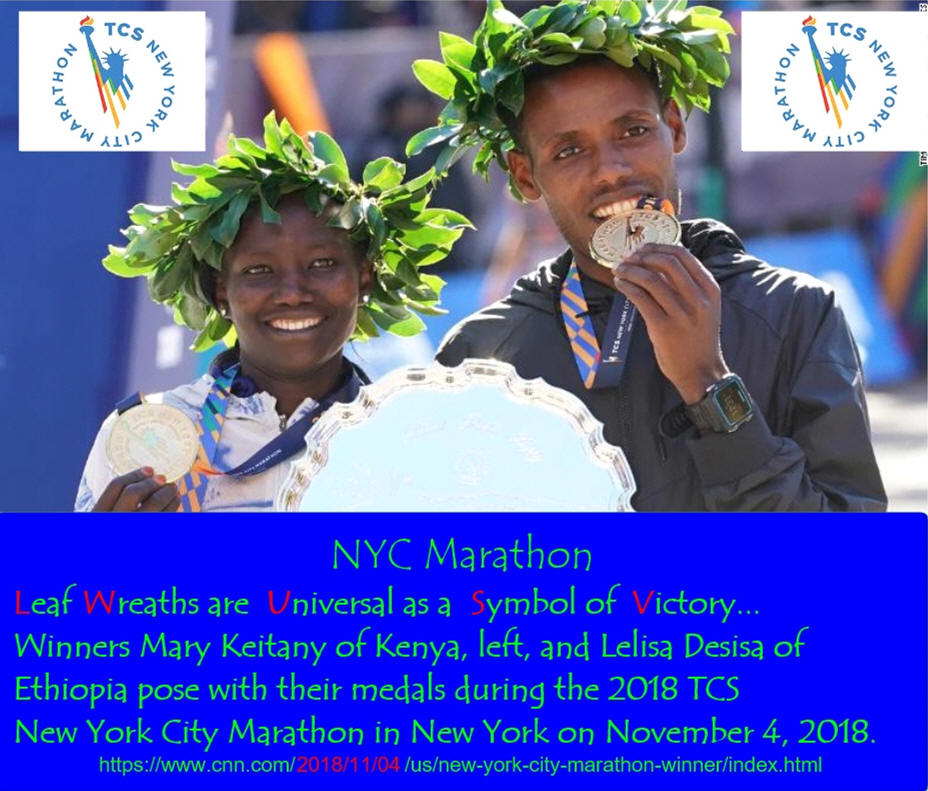
No-Fly Zone:
Before the abduction of Sita and ensuing batttle, Ravana was up to no good.
Ravana confiscated the Pushpaka Vimanam (aerial car) from his defeated
half-brother Kubera and flew all over the world. He flew over the
Himalayas. When he wanted to fly over Kailas, the abode of Siva and
Parvati, Nandisvarar, the Bull Vahana of Siva and Parvati declared Kailas
was a no-fly zone. Ravana was mad and cursed Nandi to acquire a monkey
face. The would-be monkey-face bull got very angry and counter-cursed Ravana
telling him that one day a monkey will destroy his town.
There was a fierce exchange of arrows and missiles. When Ravana lost head or heads from arrows, they regrew. Trijata told Sita, Ravana would die, when Rama shoots an arrow into Ravana's heart. That was his achilles heel. Trijata was the devotee of Rama. When the war was over, Trijata goes with Sita to the kingdom of Ayodhya in Pushpaka Vimana, confiscated after Ravana's death.
Trijata, daughter of Vibhishana, is described as half-Aryan. Vibhishana's wife was Aryan, who it is surmised convinced her husband to join Rama.
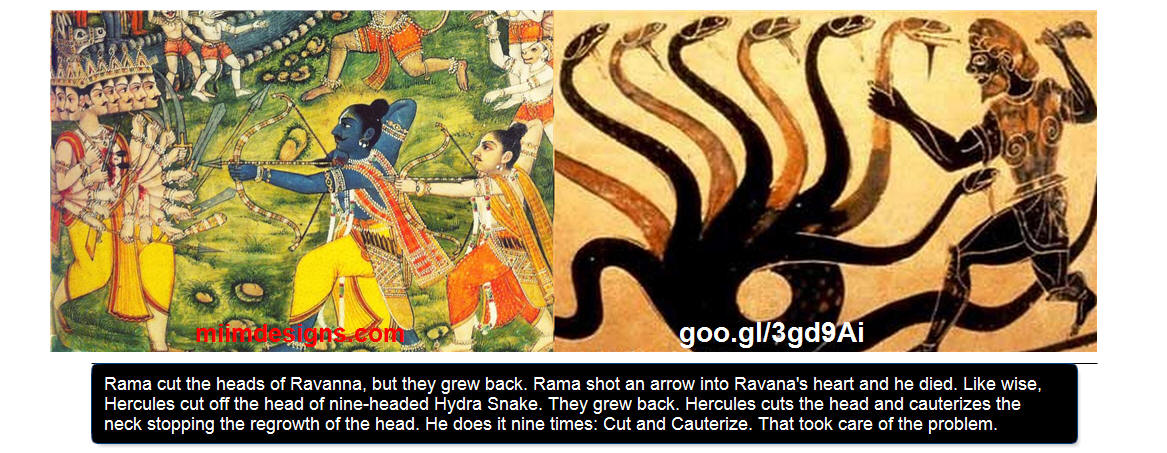
Achilles heel is the weak spot.
Ms. Thetis gave birth to Achilles.
She wanted him to live forever. To confer immortality on her son,
she held him upside down by his heel and dipped him in the Styx river.
Since her thumb was on the achilles tendon, it was dry and vulnerable.
Achilles won many battles of the Trojan war because no one
including Hector knew his vulnerable spot.
Paris, the prince of Trojans shot an arrow on the heel, not wet in the
waters of Styx. Achilles died.
Ravana stored his pot of Amrta (Nectar of Immortality) in his abdomen. Clever dude indeed! Rama cut his head; it grew back, facilitated by Amrta in the abdomen. His weak spot was his heart. Coming to know of these two factors, Rama aimed his arrow to pierce the heart and empty the pot of immortality by Agni Astra in the abdomen. Since Ravana's Amrta was no longer in his abdomen, he could not regrow his head; the vulnerable ripped heart bled from penetration with Brahmastra and he died.
The Immortal worm that regenerates. https://goo.gl/eaSuAD
Immortality is something gods and men desire. Gods have it because they only imbibed the Nectar of Immortality. Man did not and therefore, is mortal. Now take the panther worm. Chop it up any way you want. It will regenerate. Could it be possible it ate the Ambrosia?
Chop Up a Worm. It Will Regenerate. Scientists Figured Out Why.
Chop Up a Worm. It Will Regenerate. Scientists Figured Out Why.
Slice a three-banded panther worm in half or thirds and within eight days you’ll have separate fully functioning worms.
Credit
Kathleen Mazza-Curll and Mansi Srivastava/Whitehead Institute
Credit: New York Times
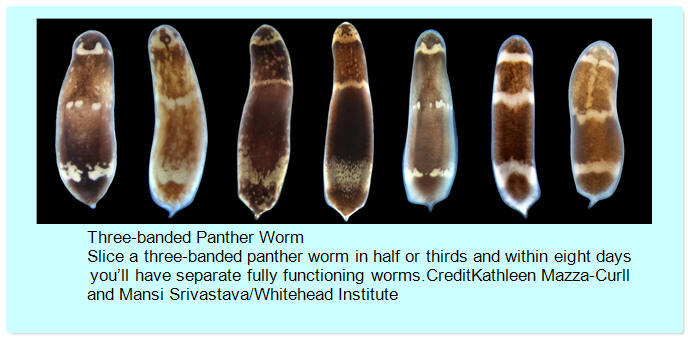
Slice a three-banded panther worm in half or thirds and within eight days you’ll have separate fully functioning worms. CreditKathleen Mazza-Curll and Mansi Srivastava/Whitehead Institute
By Heather Murphy
March 20, 2019
An essential rite of passage for many an otherwise nonviolent child involves cutting an earthworm down the middle and watching as the two halves squirm. One half — the one with the brain — will typically grow into a full worm.
Scientists have now identified the master control gene responsible for that regrowth in one particularly hardy type of worm. How hardy? Chop the three-banded panther worm in halves or thirds — either crosswise or diagonally — and each segment will regenerate just fine, said Mansi Srivastava, a professor of organismic and evolutionary biology at Harvard University. Within eight days, you’ll have two or three fully functioning new worms, mouth, brain and all.
“It’s hard to kill them,” she said.
Dr. Srivastava and her co-authors published a paper Friday outlining their genetic discovery. The process is known as “full-body regeneration,” and the term has captured the imagination of many individuals ready for a fresh start or second self.
“I’ll get a new body right now!!” one person wrote in a lively Reddit thread about the finding, adding “I knew it was coming!!” Another posted: “Two of me working together and sharing our stuff? Count me in!”
The concept of regeneration was in India even before the scientists discovered it in modern times.
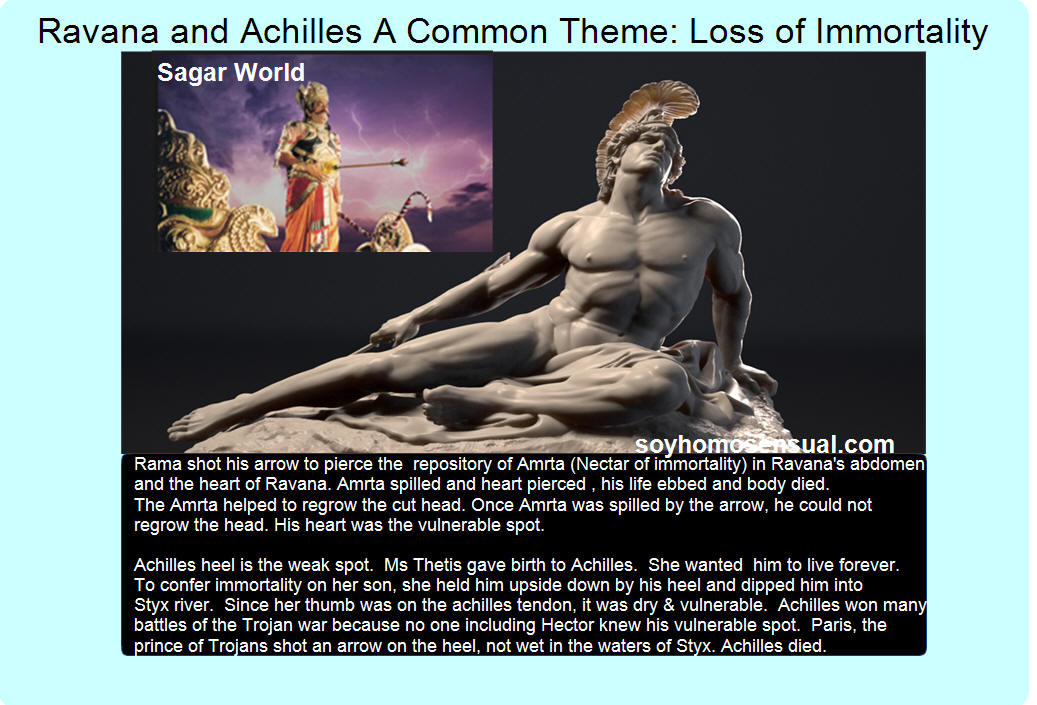
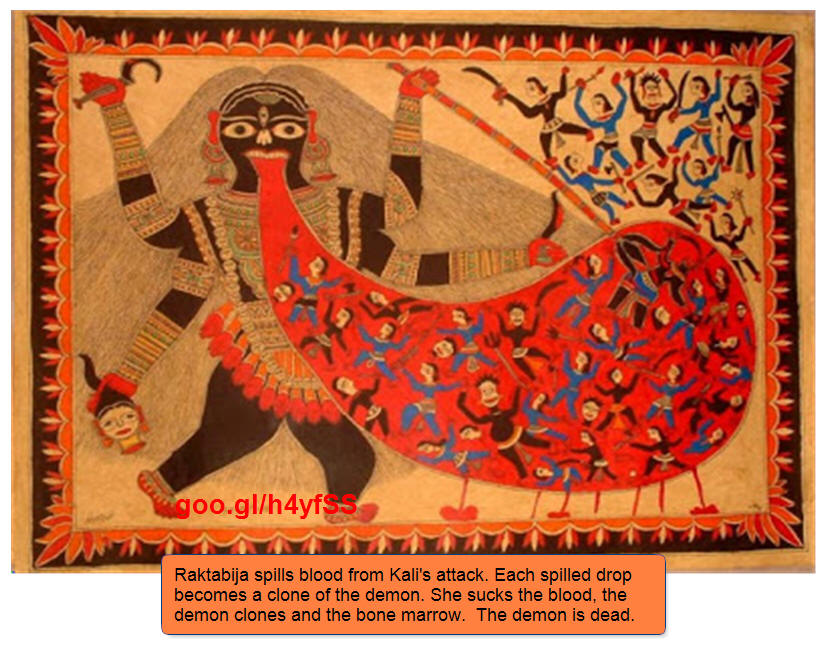
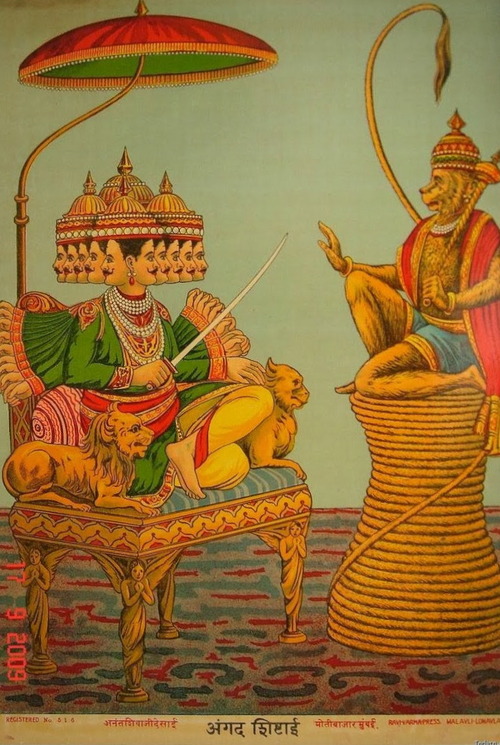
Sita is in captivity under an Asoka tree guarded by Rākṣaṣis
(ogresses). Hanuman
begs Sita to ride on his shoulders and says he will take her with a skip
and a jump to Rama. Sita politely declines his offer and says only Rama
must appear before her and rescue her.
Hanuman feels his unbound energy whirring, and waiting to unwind. He
destroys everything in sight.
(I remember a childhood experience. A troop of monkeys were sitting on
the rooftop. This kid threw a handful of peanuts on the roof with red
Spanish tiles. The peanuts lodged themselves between the rows of tiles. Next
thing you know the monkeys did a bang-up job looking for peanuts. They
found all the peanuts and the proof was their cheek pouches were bulging
with shelled peanuts. That was the proof and now hear about the roof.
The neatly lined-up roof tiles were thrown helter-skelter. Lesson: Don't
feed monkeys sitting on a Spanish style roof tiles.)
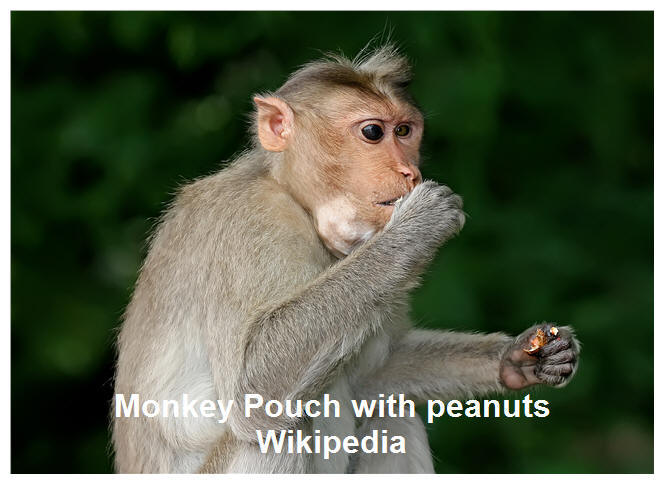
Rākṣasas came in droves to kill Hanuman. They
were no match, and were dispatched immediately to the land of eternal
rest. He was immune to their weapons. At last Indrajit, the son of
Ravana shows up and launches Brahmāstra, a weapon of instant
destruction. Hanuman is still standing and lets Indrajit capture him.
Hanuman has mischief up his sleeves and tail. Indrajit takes him to his
father's court. Hanuman saw ten-headed Ravana sitting on a golden lion
throne supported by four legs:
Hubris, Lust, Pride and Jealousy. Hanuman is the
ambassador from Rama. Ravana does not have time or inclination to honor
the court protocols for emissaries. He denies Hanuman a seat. That denial gets his goat
and Hanuman's tail grows longer by intention. Guess what. He winds the
tail in coils and sits on top of it, so the coiled tail-seat was higher
than Ravana's throne and his face above Ravana's. He was equal, rather
more equal. Exasperated by Hanuman's long-tail antics and tactics, Ravana raised his
throne a notch higher. You thought only nowadays, we have chairs with
adjustable backrest, headrest, armrest and seat height. Not so. Hanuman followed suit and raised his seat. Ravana
wanted to kill Hanuman. Vibhīṣaṇa prevailed against it.
Rāma, Rāma - What a-rāma (a Sight): Fire, Fury, Flash & Flamboyance
-rāma is a noun suffix meaning "sight, view, spectacular display or instance of," 1824 CE, abstracted from panorama (q.v.), ultimately from Greek horama "sight, spectacle, that which is seen." Examples: Vote-a-Rama; Spic-o-Rama; Scam-o-Rama; Windowrama; Groove-A-Rama; Bannanarama; Hobbyrama; Word-O-Rama; Casinorama; List-O-Rama...
Panorama, foodarama, cinerama, dancearama,
Cylorama, Futurama, Telerama...
Without wasting much time, Hanuman comes straight to the point:
Immediate release of Sita unharmed and honorably for transport to Rama,
who will forgive him for his transgression. Ravana thinks to himself.
'You are a simian. What can you do to a mighty king like me?' (At this
time Ravana does not know the divine protectors of Ravana and Sri Lanka Siva
and Parvati left the Island leaving both vulnerable. Maruthi (Hanuman,
Anjaneya), though
considered the son of Wind-god, is really the biological son of Siva.
The Wind-god transported the vital fluid of Siva and deposited it in the
womb of Anjana, Maruthi's mother. The Son of Siva: Who can take him? His
ten heads hatch a plan to humiliate Hanuman. Hanuman was an Amsa (a mote
or a fragment) of Siva. Ravana: 'you have a mile-long tail. See
what I can do with it.' He calls the minions to wrap the end of the tail
with oil-rags and set it on fire. Not a good idea, esp if the owner of
the tail is a
monkey, that too Anjaneya! A monkey with a flaming tail!
That is a sight to see. Rama, Rama,
What-a-rama!
That is fun to watch, if your are not Ravana. It did not catch fire. Hanuman
suggested to Ravana to blow on the oil rag. Stuuuupid Ravana blew on the
tail, which caught fire and singed the beards and mustaches of his ten
heads. If Ravana had half the brain of Hanuman, he would not have taken
the advice of an apparent monkey. Ravana slapped himself (He needed that.) on ten faces to put out the fire,
provoking laughter. Poor decacephalous Ravana, he did not understand,
though endowed with ten parallel processors- what Hanuman can do with his
lit tail, leaping flames and brilliant head.
Rama, Rama, What a Ravana.
Flames: Credit YouTube.
Rama, Rama, What a -rama (= a Sight, a Spectacle).
Yes, every
monocephalic human guessed it right, while polycephalic Ravana had no
clue. Hanuman whipped
his tail and escaped from the guards and the palace by shapeshifting to
a small size. Once he was out, he became very large. He is off in leaps
and bounds and flies all over Lanka, setting everything on fire. Sita
invoked the fire-god Agni (timely help), who kept the fire alive at the end of the
tail without burning it. I bet the wind-god (the putative father) was
fanning the flames of the tail without burning it. The destruction was
the handiwork of Siva because Hanuman was the Amsa of Siva. Hanuman spared
Vibhishana's palace and the Ashoka gardens from the ravages of fire. The
ten heads of Ravana depict ten bad qualities:
passion, pride, anger, greed, infatuation, lust, hatred, jealousy,
selfishness and crookedness (Swami Sivananda).
Once the land of Ravana goes up in smoke and fire, he dips his flaming tail in
the Gulf of Maṉṉar, shortens it to its normal length and goes to Rama.
Remember, Hanuman is a Yogi. He can do all these things.
Hanuman's body is the Amsa of Siva and his tail is the Amsa of Sakthi.
Amsam = part, portion or fragment. That is why Hanuman's tail was so
powerful. Just a nub of news: We all have a nub of tail in us, reminding
us of our tailed distant ancestors. Some
babies are born with a visible nub of tail. That tail is a telltale
evidence of our emergence from the phylogenetic tree of apes.
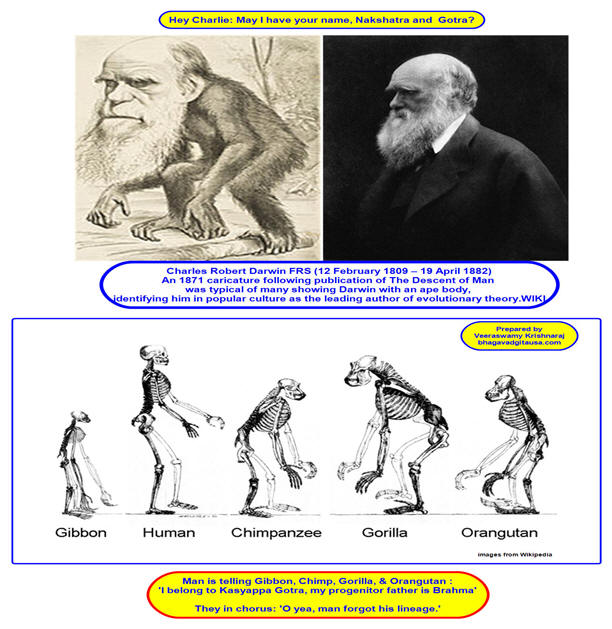
Look at the skeletons of all in the
above image. You see a nub of bone where the tail should be.
Vānara = Vā + Nara = Monkey + Man (Hanuman and
Sugriva).
Vā + Nara = Forest + Dweller.
மனிதன் = மன[ம்] + இதன். = மன(ம்) = Mind; will; the reasoning faculty +
இதன் =
நன்மை
உள்ளவன் =
possessor of goodness.
மனிதன் =
Man =
The One who is the possessor of goodness of the mind and reasoning faculty.
Ravana's supremacy on earth came from the boon given to him by Brahma.
Ravana was an Asura (Raksasa). Asura = A + Sura = No + wine, liquor. The
Asuras do not imbibe alcohol. It means that gods (Suras) imbibe not only
alcohol, but also Soma. The gods have good speech, but imbibe alcohol
and Soma. The gods get inebriated from alcohol and begin hallucinating
from Soma. You may surmise when the gods were in stupor, the Daityas
(Asuras, sons of Diti [= Limited]) won over the Adityas (sons of Aditi
[=Unlimited]). The gods are drunken and hallucinating polymaths while
the Daityas were usurping and abstinent neophytes: that is the
impression we get from sacred texts. There were exceptions. (Ravana is a
polymath.) The Asuras ( A+ Sura = Not god; Antithetical to gods; evil
cousins/half-brothers of gods, Ravana included, belonging to Daitya
class felt cheated out of Amṛta (Ambrosia) from the Milk Ocean. Brahma
gave them a long life, the next best thing to immortality. Ravana was
jittery because he saw threats from Devas, other Asuras, Gandharvas,
Yakshas, Nagas...Brahma obliges him with protection from the above
beings. Brahma's boon was a truncated boon: Only Brahma knew
its limitations. Ravana did not worry about Naras (humans), because they
posed no threat in his opinion. Power-hungry Ravana conquers the world
and ousts the Devas (Suras) from the heaven. All the oppressed go to Brahma and ask
him how to defeat and destroy the tyrant, rabid Ravana. Brahma told them
Ravana did not request protection from Naras (humans). He suggested to
go to Vishnu, who promised to take Avatar as Rama to destroy Ravana. Rama
in truth was neither a complete man nor a complete god. Rama was a
hybrid, transcending both man and god. That hybrid constitution and
personality spelled death to Ravana, who did not ask for protection from
a hybrid Being. (See, the theory of hybridization was known in
India.) Note: Adityas and Daityas are half-brothers born of
sisters Aditi and Diti and a common husband Kasyapa. Adityas are
gods and Daityas are demons. Man can be a god, a demon, a mix of god and
demon, plain god or devlish demon.
Sugriva or Hanuman is neither a god, nor an asura, nor a human, nor a
Raksasa, nor a Gandharva, nor a Yaksha nor a Naga. So, both of them are
beyond the reach and provision of safety and protection offered by Brahma's boon.
Ref--Adapted from Hanuman's Tale by Philip Lutgendorf
Vidyādharars,
Gandharvas, Siddhars, Devās, and Apsarases (Celestials) joined and created
from their individual Amsas,
Vāṉara warriors. These created warriors
inherited the power of the Devas. Brahaspati’s Amsa created a warrior by
name Thāraṉ. Kubera’s Amsa created Kandhamādhaṉaṉ. Visvakarma’s Amsa
created Naḷaṉ. Agni’s Amsa was Nīlaṉ. Asviṉi Dēvas created Myindhaṉ and
Dvidhaṉ. Varunan’s Amsa was Sūṣēṇaṉ.
Vāli and Sugrīva were the heads of the
Vāṉara warriors. Vāli established his kingdom in Kishkinda and protected the
Vāṉaras. Añjaṉai had her son
Āñjanēya
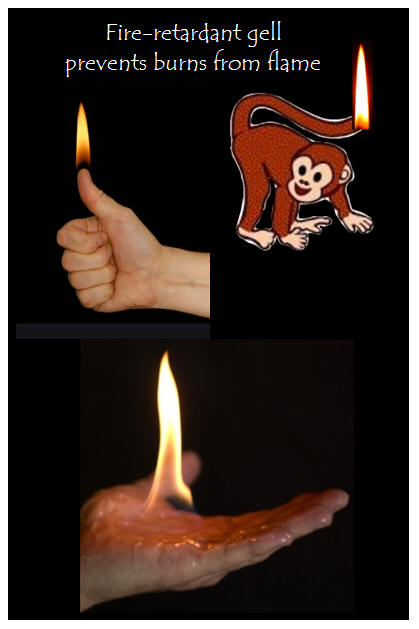
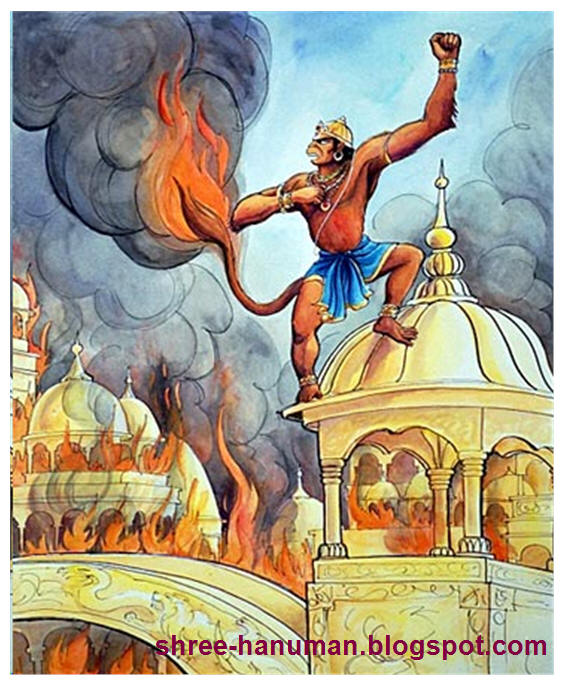
Indonesia
Stamp issued on January 24, 2016 showing Hanuman burning down Lanka:
https://topyaps.com/ramayana-stamps-from-southeast-asia/
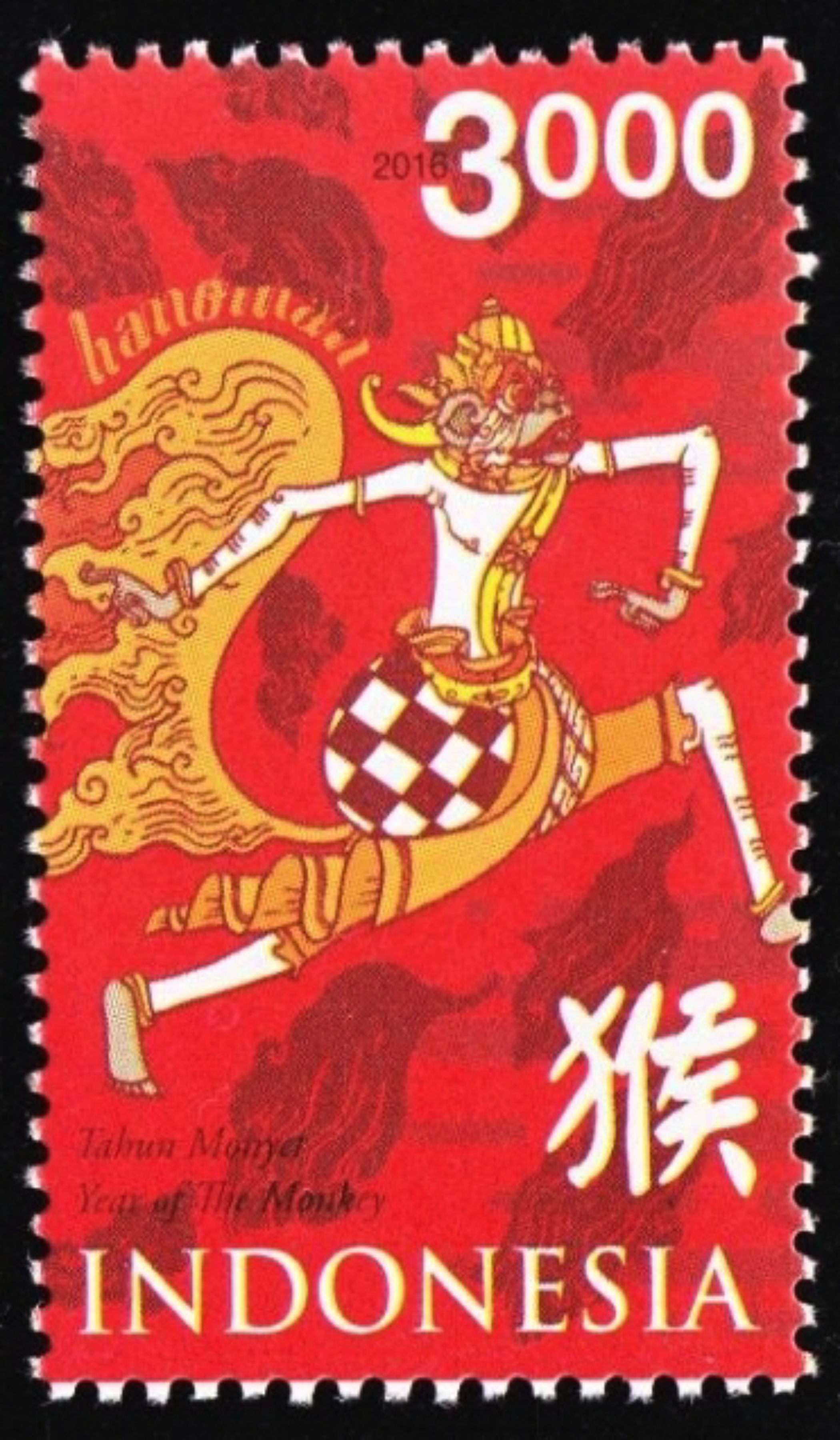
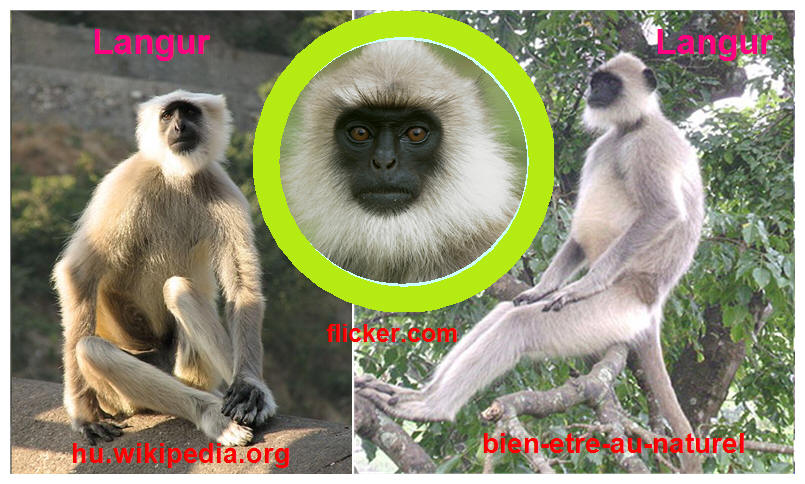
Polynomial Hanuman goes by a multiplicity of names.
1.
Hanuman: The one with prominent jaw.
2.
Añjaneya: Son of Anjana. Metronymic name.
3.
Kesari Nandan: Son of Kesari.
4.
Maruti: Son of the Wind.
5.
Bajrang Bali: The Strong One.
6. Sankata Mochana: The Remover of Dangers.
7. Pavanputra pavan = Wind or Siva (Son of Wind-god or Siva)
8. Anjaniputra (Son of Anjani)
9. Chiranjivi. One of the seven immortal beings who will live until the end of the present Kali Yuga.
Kamban of Kambaramayanam praises Anjaneya in terms of the Five Great Elements as follows. He is the son of the Wind. He jumped across the Water Element to Lanka. He traversed the Sky to reach Lanka. He saw Sita, the daughter of the Earth in the Asoka forest. He torched Lanka with the Fire Element.
Hanuman: One having a jaw (haum) that is prominent (mant)".
Images: Credit Wikipedia. Source Mathura Museum. Anjana holding Baby Hanuman in the right hand.
Hanuman is the quintessence of strength, heroism,
excellence, Sakti and Bhakti.
Hanuman = Hanu +Mant = Jaw + Prominent
Hanuman means, 'Heavy-jawed.' He is the paragon of Virtue, and the
epitome of self-control, faith and service under difficult circumstances
belying his looks. He was a great warrior, a friend and a devotee of
Rama...
Hanuman at birth was not naked like all newborns but he wore divine jewels, a red loincloth, Munja grass sacred thread and two invisible gold earrings, the latter seen by Rama only at his first encounter. He had a short and thick neck. His face was round like the moon and red like the fire. His fangs were white and sharp. The poet describes his mane as a wreath of Asoka flowers. His flailing tail was like the flapping Indra’s banner. Hanuman can grow in all directions in an instant. The ‘Incredible Hulk’ the American TV series depicted a hero who grew and expanded instantly ripping his clothes, when he was righteously angered. Yes, he was all 7 feet and 330 lbs., when he blew his stack. Incredible hulk was no match to Hanuman, who can shapeshift to an atom or to the size of a rippling mountain, billions, zillions or octillions of kilograms in weight. The saying goes, "Don't judge a book by its cover." Likewise, don't judge Anjaneya by his appearance. He was a Vedic Scholar. He was the Son of Siva. His Guru was the Sun Himself. Why sun? Because sun illuminates everything in its sight. When Rama met Anjaneya, he was greatly impressed by his chaste language, perfect diction, precise grammar... (I wish I have them.) Rama stated his heart, mind and soul were thoroughly delighted by Hanuman's speech. Hey, you see a Valmiki, a Kamban, a Shakespeare... in Hanuman.
April 13, 2019. The two, one a prince and the otherr a monkey meet. A wind-blown Saukanthika Flower (Indian Blue Water-Lily) landed on polyandrous Pāñchāli’s lap. A whiff of the smell of the flower tickled her olfactory sense. She immediately took a liking for the wayward flower that fell on her lap. Bhīma was sitting by her side. Pāñchali told him, "I like the flower. Could you fetch me a bunch of them?"
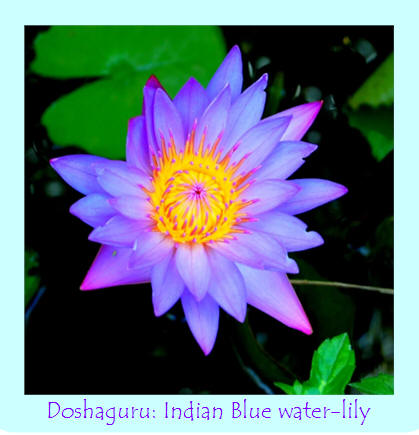
Bhīma said, “I will fetch that flower, no matter where it is: Dēvalōka
(heaven), Pātālam (Netherworld), or anywhere else.” Saying such words of
reassurance and endearment, he left in search of flowers. You thought it
must have been a short trip to a flower girl in the market. No! He walked
and walked smelling the fragrant
flower in his quest. The fragrance titillated his senses. He doubled
down on fetching it even if it meant going to the ends of the earth.
He went north to the mountainside of Himalayas. Man, that was a long
trip for a flower. A lumbering old monkey
was slumbering on the narrow path, edged by thickets.
"Hey, monkey, Get out of my way."
"Who are you, my dear sir? If you want, you can jump over me."
I am a warrior (Ksatriya). It is not proper etiquette for me to jump over an
animal.
This to and fro Q & A went on for a while.
Bhīma was impatient, angry and exasperated at the indolent monkey.
Tell me about yourself. I want to know more about you.
I am one of the Pāndavas, born of Vāyu and a brother of Āñjanēyar.
You mean Hanumat, who has fatigued aching shoulders from carrying Rāma
around.
Listen, you insolent monkey. I can move you out of the way with my
little finger and go on my merry way. Don't you ever insult my brother?
Go on. Do what you wish.
Bhīma put his hand on the tail and lifted it. It won't move. He used two
hands in vain.
Bhīma thought this was no ordinary old stubborn monkey.
Are you a Gandharva or a Yakṣa?
The monkey laughed and got up sluggishly with moaning grunts, creaky
joints, a flailing tail and a sourpuss.
Bhīmasēṉā! Do you know who I am? I am Vāyu Putraṉ, Māruthi. I thought
you would have figured it out by this time.
Bhīma stood there spellbound, confused and speechless.
Love you Brother! I can't believe it. How did you happen to be here?
Bhīma! I was waiting for you. I knew you were coming this way. (He was
the true mind reader.) The moment Pāñchāli asked you for the flowers, I
stationed myself in this narrow path expecting your arrival. (Māruthi
was an omniscient and omnipotent yogi.)
How do I know you are my brother?
Māruthi expanded in all directions and standing tall scraping the sky.
Now Bhīma was convinced. They embraced each other fondly.
Brother! You can't go down this narrow path, forbidden for human foot
traffic and reserved only for the celestials. If you go further, you will
face danger. I will be gracing the flag of the chariot of Arjuna with
Krishna as the charioteer in the Pandava-Kaurava war. I will make sure
the Pandavas win the battle. Listen, Pāñchāli is waiting. There is a
pond over there. Pick your flowers and go home to Pāñchāli.
They hugged and departed.
Yes, Anjaneya, the Cirañ-cīvi strides and straddles two eras of Ramayana and
Mahabharata, was of great help in locating Janaki, and assuring victory
for the Pandavas.
Indrajit, the son of Ravana, saw the ferocious fighter Hanuman kill his brother Akshakumara and the five field commanders and wondered what would happen to Sri Lanka, if a troop of monkeys like Hanuman landed in his country. Ravenous Ravana saw a hero in Hanuman, observing his feat.
அக்ஷகுமாரன்
= அக்ஷயம் + குமாரன் =
Akṣaya +
Kumāran = The son of
+ the Indestructible
[Ravana]
Bee is the pollinator but not the producer of Pollen. One little bee carries the pollen from one flower to another flower. Wind god played the role of the carrier of vital fluid of Siva.
Kesari and Añjanā were a couple. Kesari was a devotee of Siva. He used to go on pilgrimages and when he found a beautiful garden in his travels, he would sit there and meditate. Añjanā and Kesari prayed to Siva for a son. Siva gave them the boon of being born in the womb of Añjanā . Siva took his birth as Hanuman or Añjaneya, his metronymic name. Ramayana is the garland and Anjaneya is the gem: Mahāmālaratna.
Though Kesari was the wedded husband of Añjanā,
Vayu - the wind-god- transported the divine power of Siva into the womb of Añjanā.
Wind-god was only a carrier (delivery boy) and not really the biological
father of Hanuman. Hanuman is an incarnation of Siva himself. Confusing?
Añjanā married ape Kesarin. She later married the wind-god who was the carrier of Siva's Amsa to the womb of Añjanā, bore Hanuman as the biological son of Siva. But why? The answer is simple. No one can take on Ravana but Hanuman. Hanuman's body must be endowed with the power and potency of Siva. Siva has 11 heads, believe it or not. Ravana sacrificed 10 heads to Siva. But he had no more heads to sacrifice, satisfy and equate the last head of Siva-Rudra. So Rudra incarnates as the body of Hanuman, and Sakthi (power) becomes Hanuman's tail. Now Ravana's fate is signed, sealed and delivered.
Anjana is an Apsaras. An Apsaras in heaven is the
most beautiful woman in the universe. Kesarin is an ape. Siva
sported as a simian when Anjana became pregnant. Anjana, the mother
of Anjaneya or Hanuman is an Apsaras, the dancer in heaven. Siva, the
biological father of Anjaneya in his simian form, is God. The product is
Anjaneya. Here is the reason. When Anjana became pregnant, Siva and
Parvati were sporting in the jungle as simians. That is why Hanuman is
what he is. Does it not say there is unity in existence? All beings have
Siva in them. Vaishnavas beleive that Vishnu as the Universal Soul
exists in all beings.
There is Siva in everyone. Siva can change his appearance. Consider
this: Nandhi the Bull is the theriomorphic form of Siva. Notes
April, 8, 2019
Añjanā rode a scorpion. The scorpion sting did not
bother her. Or the scorpion dared not sting her. She was an Apsarasas, a
celestial beauty. When people are stung by scorpion, the victims pray to
Añjanā for full recovery.
When Lakshmana died in the battlefield and Rama was exhausted,
an herb in the mountain of Himalayas had the power to resurrect Lakshmana
and rejuvenate Rama from exhaustion. Hanuman flew to the Himalayas at
the speed of wind and thought, uprooted one peak with herbal plants
(Dronagiri) and
brought it to Lakshmana. Lakshmana resurrected with the help of
Sanjivani herb. Rama recovering from exhaustion blessed Hanuman with a perpetual
life.
A sea monster swallowed Hanuman, who induced
vomiting in the monster from inside and escaped.
Kalanemi
Kālanemi was a Dānava, the son of Danu (one of the daughters of Diti). Kālanemi personifies the Wheel of Time. Kāla = Time. Nemi = Circular rim of a wheel or part of the rim. Call him Wheel of Time Demon, or simply Wheel Demon. He, being a Rākṣasa, took his birth as Kaṁsa, killed by Krishna.
A Punk in the Saffron Garb of a Monk
Ravana’s soldiers died by thousands in the hands
of the Vāṉara soldiers. Jāmbhavān killed Kumbarkarṇa’s son Kumbhaṉ.
Aṅgathaṉ killed his brother Nikumbaṉ. Lakshmana’s arrow severed the head
of Ravana’s son Adhikāyaṉ, took the disembodied head to the Assembly
Hall and deposited it before Ravana. Ravana came to the battlefield with
fire in his eyes and saw Lakshmana, and his brother Vibhīṣaṇa. Calling
him the traitor, Ravana launched a Mantra-infused Sakthi missile on
Vibhīṣaṇa.
Seeing the Sakthi missile aimed at Vibhīṣaṇa, Lakshmaṇa stepped in front
of Vibhīṣaṇa, bore the brunt of the weapon and fell on the ground and
lost his consciousness. Anjaneya picked up the body and went to grieving
Rāmar. Sugriva and Vibhīṣaṇa were upset because Lakshmana took the
weapon meant for the latter.
Jāmbhavāṉ found Lakshmana alive, reassured Rama and sent Anjaneya to get
the Sañjīvī Mūlikai (The herb) from Sañjīvi-paruvatam (Sañjīvi hill),
capable of reviving a person, dead or in a swoon. Even the Herbal-Wind
can raise the dead and the unconscious to life and health.
Jāmbhavāṉ chose Anjaneya for the task. Anjaneya paid homage to Rāmar and
took off towards the Himalayas. Ravana’s spies immediately informed
Ravana who asked the Māyāvi (Conjuror) Kālanēmi to stop Anjaneya from
bringing the herb.
Kālanēmi by magical powers transported himself to Sañjīvi mountain ahead
of Anjaneya and stayed in a Hermitage with a pot of poisoned water.
Hanuman was there looking for the Herb and found the Hermitage and
Kālanēmi, the Punk in the Monk’s garb. Kālanēmi told Hanuman he knew by
Yogadṛṣti the purpose of his visit, and the need to wake up Lakshmana
from his unconscious state. He added he could help him, and invited him.
The Pseudo-Muni advised Anjaneya to rest, relax and recoup overnight and
then go for the herb next day. The Muni offered him water from the pot.
Anjaneya who chanted Rāma Nāma all the time felt a sense of unease with
the Vibhuti-stripped and matted-hair Muni. He did not drink the water
telling the Muni he was so thirsty a pot of water was not enough and he
had to go to a river for quenching his thirst and ablution. The Muni
wondered whether Hanuman got wind of his nefarious plan to kill him.
(After all, Hanuman was the son of the wind-god.) The Muni offered to
take him to the mountain and harvest the life-saving herb on his return
and actually there was no need for the herb because Lakshmana was
already safe (Yogadṛṣti).
Hanuman went to the nearby river and dipped his foot in the river and no
sooner, an alligator swallowed him whole. Hanuman enlarged his body
several times his original size and split the alligator into two parts.
He emerged from the dead alligator with an Apsaras by his side. The
Apsaras of divine beauty and effulgence paid homage to Anjaneya and said
her name was Māliṉi. She told a Muni wanted consortium with her. She
refused, and the Muni cursed her to become an alligator. If this happens
in the modern times (at least by aberrant thought of aberrant men), we
will have no women but only alligators. See you later alligator! Because of her
contact with him (Celibate Anjaneya), her curse was lifted, and she was back to her own
self. Māliṉi added that Ravana sent the matted-hair Muni in the
Hermitage to sabotage his plans and kill him. She later left for her
place.
The Muni invited Anjaneya back to his Hermitage and offered to instruct
him on Mantras. As a Guru Dakṣiṇa for his Mantras, Anjaneya pounced on
him, delivered a blow on his chest, saw him vomit blood from his mouth
and die. (He is Kalanemi and takes birth again and again to kill Vishnu
in his avatars and Vishnu's servitors.)
Chanting the name of Rama, he went to the Meru Mountain and could not
identify the Sañjīvīni herb because all herbs were radiantly beautiful
from the divinity of the mountain. He sheared the mountain off its base
and flew with it to the battlefield in Lanka.
As he approached the battlefield, the dead Vāṉara warriors came to life
with the Herbal Wind blowing on them. Before Añjaneya could arrive at
the battlefield, Vibhīṣaṇa and Sugriva buried the dead Arakkar soldier
deep in the sea so they would not come back to life. As the Herbal-Wind
touched Lakshmana, he woke up from his unconsciousness. Once all Vāṉara
warriors and Lakshmana were back to life and consciousness. Hanuman took
the Herbal mountain and put it back in its place. He did not dispose it
as trash, as we do. Hanuman must have been an environmentalist and a
conscientious recyler.
More Arakkars died. The news of Lakshmana’s resurrection shattered
Ravana, who sent Kumbhakarna to the battlefield, defying the latter’s
advice to return Sita to Rāmar.
Here is
another version. Kālanemi was the uncle of Ravana, who sought the help
of Kālanemi to kill Hanumat -remember he set Ravana's kingdom on fire-,
the friend of Rama, with a promise of dominion over half his kingdom.
Kālanemi disguised himself as a recluse and invited Hanumat for a
sumptuous eight-course dinner. Name a monk in the forest who gave an
eight-course dinner! Hanumat declined his invitation and went
to the river for ablution. Would you accept a dinner invitation from a
total stranger? A crocodile in waiting, seized him by the
foot and dragged him into the depths of the river.
Hanumat killed the croc. Out of
its body emerged an Apsaras, a beauty of all climes, times, and poems. She was cursed a long time ago by Dakṣa to
become a crocodile with a promise she would be released when the
crocodile died in the hands of Hanumat. Release from the curse
exhilarated her and she warned Hanumat that Kālanemi intended to kill
him at the behest of Ravana. Dinner invitation was the ruse of the false recluse. Hanumat
returned to the hermitage, caught Kālanemi by his heel and flung him so
hard he landed before the throne of Ravana in Laṅkā to claim half his
kingdom unconvincingly.
Vayu Bhagavan the life sustainer of all air-breathing beings can become cyclonic and violent. In Vedic times, Vayu, Varuṇa and Agni were the Holy Triad. You heard about the Aryans. They were a nomadic tribe. They knew their cattle, the horse... They lived under the sky, were drenched by the rain..., What they could not control, they apotheosized as gods. Naturally they worshipped the pentad as gods: Akasha, Vayu, Agni, Jala and Prithvi = Ether, Air, Fire, Water, and Earth. They wanted to pacify and control these elemental gods. They offered sacrifices to these gods, to whom they gave names: Indra, Varuna... Their list of gods expanded. They dug pits for fire sacrifice. The fire-god carried the supplications of the Indo-Aryans to the gods, who send them rain... To them, the relationship with gods was transactional: I give you sacrificial offerings and you give me something in return: rain, cattle... These commercial transactions went to a ridiculous extent that the purveyors of fire sacrifice declared that gods will die of starvation if not for their sacrifices. Later, the elemental gods were replaced by the holy triad: Brahma, Vishnu and Siva. Brahma has one or two temples in India, while Siva and Vishnu have innumerable temples and devotees. The reason is Brahma told a lie to Siva saying he found the bottom and the top of Siva as a fiery column and conscripting a false witness to lie for him. Vishnu was humble and told the turth that he could find neither the bottom nor the top. Siva became angry and cursed Brahma that he would not have any devotees or temples in his name. The Indo-Aryans turned their mind inside and came up with deep thought philosophy. In south India, there was flowering of Saiva Siddhanta, Divyaprabhandam, Kural...
The wind-God
in his violent temper broke the summit of Mount Meru, the Axis Mundi,
egged on by Narada Muni. Garuda spread its wings over Mount Meru and
protected it from Vayu. In an unguarded moment of Garuda, Vayu ripped
off part of the Mount Meru and threw the humongous rock in the Indian
ocean creating the Island of Sri Lanka. You thought Sri Lanka formerly
Ceylon is sitting on the Indian Plate, a tectonic plate, part of the
Indo-Australian Plate. That is science. Now the mythology. Sri Lanka is
a teardrop island, the summit of Mount Meru broken by Vayu Bhagavan and
lobbed into the Indian ocean just south of Ramesvaram. The tsunami
created by this catastrophic fall of the mountain peak spread around the
world creating 100 foot waves. It took a year for things to return to
normal. If you are a mythologizer, the latter sounds very believable.
Hanuman, Vayu's putative
son, broke the summit of
Dronagiri the life-saving herbal peak and transported it for the revival
of Rama and resurrection of Lakshmana. Hanuman was following his
putative father’s footsteps (that of Vayu Bhagavan). Both Vayu Bhagavan
and Hanuman break and move mountains.
Hanuman’s biological father Siva lives in Kailas the snowcapped mountain
peak and married Parvati, the daughter of the king of mountain, Himavan
(= Himavat = Parvat = mountain).
Vayu Bhagavan was a lecher (Sorry to out [expose] him), though married to the daughter of Visvakarma (the great architect of the gods) in addition to Bharati and Swasti. Vayu Bhagavan was the original Long Dong Silver. His male hormones must have been raging wild. That over-produced, under-expressed and redundant energy, he used to break the summit of Mount Meru, while his father-in-law Visvakarma was an architect and a builder. He was like the rutted elephant, a zillion times more so. O my, run for cover, if you can beat his long transcontinental strides.
Vayu Bhagavan had a man cave called Gandhavati. On his outings, he rode
a gazelle carrying a flag.
Deities preside over and protect our organs: Eyes, ears... People can live
without them but not without the Wind-God. When he leaves, he leaves
behind a dead body. He is that important for life and living.
Wind-God always travels with Vishnu, Lakshmi and obviously Garuda. Long
live the Wind-God in you.
You hear moms telling children Not To Play With Food. You know people throw a peanut up in the air and catch it with the open mouth. Animals do them too. Take a pod of Killer Whales at sea. They surround the seal taking a sunbath on the ice float. A pod circles around the sun worshipper. One whale hits the seal with its tail fin. The seal goes up 80 feet into the air. It is disabled, and disoriented, and on its way down, enters the cavernous mouth of the killer whale.
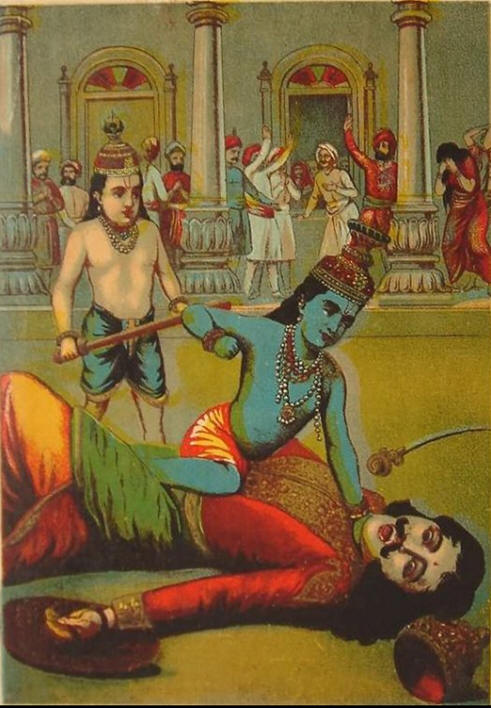
"Vibishan comes no crafty spy :
Urged by his brother's fault to fly,
With righteous soul that loathes the sin,
He fled from Lanka and his kin," --Kamba Ramayanam
Translation by M.S.Purnalingam Pillai 'Ravana the king of Lanka'
The painting Of Vibhishana's Surrender: Credit: legacyofwisdom
When Hanuman was tortured in the court
of Ravana, fearless and brave Vibhīṣaṇa told Ravana, “It is very wrong
to persecute an emissary.” Because he continued to point out Ravana’s
evil ways, Vibhīṣaṇa was chased out of the palace. He took refuge with
Rama. No one except Rama and Lakshmana were prepared to trust him. Other
compatriots of Rama looked at him as Ravana’s spy.
Hanuman pointedly spoke of the support he received in Ravana’s court
from Vibhīṣaṇa and was responsible for Rama’s decision to offer
Vibhīṣaṇa refuge. This is what we call as Saranagathi.
Saranagathi or Prapatti in Vaishnavism
is a total surrender to God.
Surrender in Vaishnavism goes beyond the dictionary meaning. It is a
technical term. The following is what it means. I do not know what
Dharma, Dhyana, and Bakthi mean. They are foreign to me and my being. I
am a destitute (அகிஞ்சனன் akiñcaṉaṉ, n. < a-kiñcana. Destitute person;
தரித்திரன்.). This destitute surrenders to you: Vishnu, Rama, Krishna,
and their consorts.
Bhagavadgita 18:66
sarva-dharmān parityajya mām ekam śaraṇam vraja
aham tvām sarva-pāpebhyaḥ mokṣyayiṣyāmi mā śucaḥ 18.66
Krishna Paramatma says in bhagavadgita:
(18.66) Abandoning all duties, come to Me alone for shelter. Be not
grieved, for I shall release thee from all evils. Translation by Dr.
Radhakrishnan. The painting Of Vibhishana's Surrender: Credit:
legacyofwisdom
In the war that happened later, Indrajit’s (Ravana’s son) Brahmāstra felled a multitude of fighting monkeys. Hanuman on the suggestion of Vibhīṣaṇa through Jāmbhavān brought Sañjīvī mountain whose herb restored the breath of Lakshmana and resurrected the whole contingent of dead monkeys. (Poetic license: You must see those raucous anabiotic monkeys with flailing tails gorge on the bananas that fell from the heavens as a reward for their sacrifice.)
Indrajit
performed Nikumpalai Yāgam. With his illusory power, he created an
illusory Sita, stood her before Rama and the monkeys, and killed her by
the sword, though he let the real Sita to remain in Asokavaṉam. Vibhīṣaṇa told
Rama and Lakshmana it was a magical play and ploy, which they should not
believe.
When the Ravana Vatham (death of Ravana) happened, Vibhīṣaṇa was
installed king of Lanka by Srīrāma.
However, for the timely help by Vibhīṣaṇa and his divine qualities, what
Rama wanted to give was not gold or wealth, but Prāṇavākāra Perumal!
The war was over. Rama came back
to his kingdom and ascended the throne. Rama gave gifts to all who
helped him. He gave a large pearl necklace to Sita, who gave it to
Hanuman. He broke open every pearl. People were wondering what he was
doing. Some said, “After all he is a monkey. He sees food (a banana) in
everything." One challenged Hanuman what he was doing. Hanuman said, he
broke each pearl to see Rama and Sita inside each pearl. He did not find
them, so they were worthless. A courtier came forward and said, “Does
every object contain God inside to be of value? Is your body made of
five Mahābhūtās” (Five great elements) have any value?
Hanuman stood up and ripped open his chest and
showed his heart. Hey, Hanuman can do such things, put them back and
look normal again. Everyone saw Rama and Sita enshrined in his heart.
Rama's name was engraved on his bones (You are curious what language it
was. Possibility: Tamil and Sanskrit) and inscribed in all cells of his
body. He then passes his hand over his chest; it closed and looked
whole again. Sita smiled.
Hanuman's Heart. Pinterest
The opening of the heart to reveal The Divine (in Hinduism and Christianity)
Sep 30, 2004
by Mandakranta
Bose
Hanuman had distrubing dreams. Hanuman somehow knew the import (behind the dreams). He realized what his anxious ancestors told him in the dreams: “Hanuman, you offer oblation to us in a proper manner. After your demise, who will offer oblations to us?"
Knowing the unhappiness and its cause, Sita Devi
said, “Hanuman, don’t be disheartened. Go to Kishkinda and bring back a
bride. I will conduct the wedding ceremony. Your progeny will perform
śrāddha for the ancestors."
Hanuman sets out on his quest, he wonders how he would
On the way, he came across the noble king of Tumba, Cañcarīka
and
Ṛṣi
Lomaṣa.
They do not provide the right answers in the choice of
a
bride. Hanuman goes to the monkey king Sugrīva
with 18,000 wives. If anyone should know about women, he is the go-to
monkey for advice. Sugrīva
keeps their (wives) mouths shut with utility tape. (Speak only when you are spoken to.) This enforced silence keeps the peace. Hanuman is
unsatisfied with Sugrīva’s
treatment of his wives. Sugrīva
wants to unload his aging wife Tārā
as the bride of Hanuman, who does not fall for the hook, line and sinker and ignores the
offer. Thanks, but no thanks. Sugrīva’s
other advice was to seek the hand of monkey princess Cilimpā
in the neighboring kingdom. Princess Cilimpā
just inherited the kingdom from her father and puts all her suitors to
rigorous tests. Failure of tests draws the punishment of getting the tail cut
off. What is a monkey without a prehensile tail? A human! Hanuman the Vedic
scholar and a chaste and precise grammarian taking a test? Ridiculous.
When was the last time you asked your English professor to spell,
supercalifragilisticexpialidocious? Outrargeous.
Ignoble, Anomalous. Hanuman carries her off by the hair and
flies to Ayodhya. (Take it easy, Highflyer! It is no way to treat a
simian princess.) Cilimpā's
hubris melted, mellowed and ran out. She was impressed with the virility and vitality of
Hanuman and announces her love for him on her maiden voyage on the shoulders of Hanuman.
(Hanuman Dear, you passed the test!) Hanuman asks her
to keep her mouth shut, an advice from Sugriva. Cilimpā
is a chattering princess. That is her nature and prerogative. The short-lived romance for Cilimpā
ends. Hanuman sees from the blue sky Sugrīva
sporting with his 18,000 wives in the Tungabhadra river and drops off
Cilimpā
on his laps,
of course gently.
Hanuman goes to Ayodhya empty-handed and reports to Sita he has no room for a wife
and child in his heart already occupied by Rama and Sita. The only
solution is for Hanuman to live forever not as a forlorn bachelor but as
blessed bachelor with Sita-Rama in his heart, mind, soul, every cell of his body,
and speech so he can perform
śrāddha to his
ancestors. Sita gladly blesses Hanuman with the boon of a long life.
http://www.hanumanchalisalyrics.com/category/hanuman-chalisa-in-english/
Hanuman Chalisa Full Meaning in English
Hanuman Chalisa is a devotional hymn of 40 verses dedicated to Lod Hanuman.
Having polished the mirror of my heart
with the dust of my Guru’s lotus feet,
I sing the pure fame of the best of the Raghus,
which bestows the four fruits of life.
Knowing this body to be devoid of intelligence,
I recall the Son of the Wind.
Grant me strength, wit, and wisdom,
and remove my sorrows and shortcomings.
1. Victory to Hanuman, ocean of wisdom and virtue,
Hail Monkey Lord, illuminator of the three worlds.
2. Ram’s emissary, abode of matchless power,
Anjani’s son, named “Son of the Wind.”
3. Great hero, mighty as a thunderbolt,
remover of evil thoughts and companion to the good.
4. Golden-hued and splendidly adorned,
with heavy earrings and curly locks.
5. In your hands shine mace and banner,
a sacred thread of munja grass adorns your shoulder.
6. You are Shiva’s son and Kesari’s joy,
your glory is revered throughout the world.
7. Supremely wise, virtuous, and clever,
you are ever intent on Ram’s work.
8. You delight in hearing of the Lord’s deeds,
Ram, Lakshman, and Sita dwell in your heart.
9. Assuming tiny form you appeared to Sita,
and in awesome guise you burned Lanka.
10. Taking dreadful form you slaughtered demons
and completed Lord Ram’s mission.
11. Bringing the magic herb, you revived Lakshman,
and Ram embraced you with delight.
12. Greatly did the Raghu Lord praise you –
“Brother, you’re as dear to me as Bharat!”
13. “May the thousand-mouthed serpent sing your fame!”
So saying, Shri’s Lord drew you to Himself.
14. Sanak and the sages, Brahma, gods, and great saints,
Narada, Sarasvati, and the king of serpents,
15. Yama, Kubera, and the guardians of the quadrants,
poets and scholars – none can express your glory.
16. You rendered great service to Sugriva,
presenting him to Ram, you gave him kingship.
17. Vibhishana heeded your counsel
and became Lord of Lanka, as all the world knows.
18. Though the sun is thousands of miles away,
you swallowed it, thinking it a sweet fruit.
19. Holding the Lord’s ring in your mouth
it’s no surprise you leapt the ocean.
20. Every arduous task in this world
becomes easy by your grace.
21. You are the guardian of Ram’s door,
none enters without your leave.
22. Taking refuge in you one finds all delight,
those you protect know no fear.
23. You alone can withstand your own splendor,
the three worlds tremble at your roar.
24. Ghosts and goblins cannot come near,
Great Hero, when your name is uttered.
25. All disease and pain is eradicated,
brave Hanuman, by constant repetition of your name.
26. Hanuman releases from affliction
those who remember him in thought, word, and deed.
27. Ram the renunciant reigns over all –
you carry out his every task.
28. One who brings any yearning to you
obtains the fruit of abundant life.
29. Your splendor fills the four ages,
Your glory is famed throughout the world.
30. You are the guardian of saints and sages,
the destroyer of demons, the darling of Ram
31. You grant the eight powers and nine treasures
by the boon you received from Mother Janaki.
32. You hold the elixir of Ram’s name
and remain eternally His servant.
33. Singing your praise, one finds Ram
and escapes the sorrows of countless lives.
34. At death, one goes to Ram’s own city
or is born on earth as God’s devotee.
35. Give no thought to any other deity –
worshipping Hanuman, one gains all delight.
36. All affliction ceases, all pain is removed,
by remembering the mighty hero, Hanuman.
37. Victory, victory, victory to Lord Hanuman!
Be merciful even as is the Divine Master.
38. Whoever recites this a hundred times
is released from bondage and gains bliss.
39. One who reads this Hanuman Chalisa
gains success – Gauri’s Lord bears witness.
40. Says Tulsidas, Hari’s constant servant,
“Lord, make your encampment in my heart.”
Son of the Wind,
Banisher of sorrow and embodiment of blessing,
Dwell in my heart,
King of Gods, together with Ram, Lakshman, and Sita
August 25, 2018
Hanuman & Kauai Aadheenam: Carrying Iraivan Temple across the ocean from India; the bronze statue worshiped at our morning homa; the Hanuman bell Click the link: goo.gl/7TyvBB
The present legend of Hanuman in the 21st century is that he carried Iraivan Temple from India to Kauai.
The above painting portrays Hanuman of the 21st century (He is a Chiranjivi - The Immortal until the end of Kali Yuga.) carrying the Iraivan Temple from India across oceans to the island of Kauai in NW Hawaii. Yes, I was there with family.
There are various stories about the origin of Lord Hanuman: He was born to the Princess Anjana after she and her husband, Kesari, prayed to Lord Siva; he is an incarnation of Lord Siva as Rudra. He is found in Buddhist, Jain and Sikh scriptures and in stories from across Southeast Asia, China and Japan, where He is the divine being Saruta Biko. Hanuman may be the subject of Rig Veda hymn 10.86. He appears in the Ramayana, Mahabharata and Puranas and is best known today as the divine helper to Lord Rama.
The How, the Why, the Who, and the When. Let us go back to the future. Hawaii. In the early 1970s, Gurudeva had visions of Hanuman and received messages from Him on how to train his monastic order. As plans for Iraivan Temple unfolded, Guruda deva found it most apt to credit the monkey deva—known as the epitome of loyalty, strength and service to God—with bringing the massive temple to Kauai, just as He once transported Mount Dronagiri from the Himalayas to Sri Lanka. Click the link: goo.gl/7TyvBB
Panchamukhi Hanuman. Five-faced Hanuman: Varaha, Garuda, Anjaneya, Narasimha and Hyagriva.
Panchmukhi Hanuman: Ravana had a brother Ahiravana, the ruler of the
Underworld. During the great war, Ahiravana impersonating Vibhishana
took unconscious Rama and Lakshmana to Patala, the nether world and
secreted them out of sight. To rescue them, Hanuman had to kill the
demonic king. It was difficult. There were lamps illuminating five
directions. All lamps should be extinguished simultaneously before the
great demon of the underworld was killed. Hanuman became five-headed god
with heads placed strategically in five directions to extinguish the lamps and
the life of the great demon. The gods were east-facing Hanuman,
sky-facing Hyagrīva, south-facing Narasimha, west-facing Garuda and
north-facing Varaha. Once Mahiravana was killed, Rama and Lakshmana were
rescued.
Panchmukhi Hanuman is an auspicious Lord.
The Story of the Crystal Lingam as seen above in the Iraivan Temple, Kauai.
Coleman discovers 3' 3" crystal in his mine in
Arkansas in 1972. Hauled it to the surface and forgot about it. Weighed
about 500 lbs. In July 1987 Almitra Zion was scouting for a crystal for
Saiva Siddhanta Church. She had a vision. She found the crystal, and
bought it. On August 12, 1987, it arrived in Kauai, Hawaii. Crystals are
the highest form of Lingam.
Source: https://goo.gl/WzP4Lp
Ganesa and Hanuman are Ādhiyantham (ஆதியந்தம் = ஆதி + அந்தம் = Ādhi +
Antham = the beginning and the end)
Ādhi is the beginning and Antham is the end. Ganesa is the Lord of
New Beginnings. Hanuman is the Lord of Successful endings or conclusions.
All that begins well with Ganesa ends well with
Āñjanēya .
At the beginning of a deed, we supplicate to Pillaiyar for his help.
Once the task on hand is satisfactorily completed, we apply a garland to
Hanuman. Ganesa wrote Mahabharata using his tusk as the stylus (The
picture depiction is different.). In a way, he was there at the outset,
at the beginning of the story dictated by Vyasa and transcribed by the
Divine Scribe Pillaiyar or Ganesa.
With the beginning of a task with Ganesa worship, Hanuman brings the work
to a successful conclusion. There are several similarities between
Ganesa and Hanuman. Both are Brahmacharis and Divine and semidivine Theriomorphs (Deities
having the form of beasts.) Ganesa is divine and Anjaneya is demigod or
semidivine. Both are
Chimeras. A chimera is a being with two or more
genetically different tissues. Ganesa has the tissues of the Divine and
also of the elephant: That is a chimera. Hanuman was born of a
celestial but also has the DNA of the simian. His father is Siva
himself. It is not uncommon in
humans to have chimera of blood groups. A small number of people have
two different ABO blood types in their body. Take me: B (Rh negative),
not a chimera. "They are not simply AB codominant. Apparently, most of
these blood chimera individuals shared a blood supply with their
non-identical twin before birth."
Hanuman is the biological son (of the Amsa) of
Siva (Pavanputra = Pavan refers both to Siva and the Wind God)
Parvati is the origin of Vinayaka as said before, while Hanuman is the
Amsa of Siva. Ganesa and Hanuman derived their powers from the Divine
Couple, Parvati and Siva.
Hanuman offers four poses.
Baktha Hanuman (1) holds the opposed palms and the hands above the head
in a worshipful mode. Here in the below image, he holds the opposed
palms by the chest.
Abhayahastha Hanuman
(2) holds the right palm supine at the shoulder level.
Vira
Hanuman(3) holds a Gadam (Mace) in one hand and a hill on the other
hand. This is the common depiction in temples, images, and paintings.
Anjaneya to his devotees: "Have no fear; I am here." (A-Bhaya-Hasta = No-Fear-Hand pose)
Heramba Ganapathi. He is the 11th form of 32 forms.
The five heads of Ganesa are elephant heads, representing Siva's
aspects: Ishana, Tatpurusha, Aghora, Vamadeva, and Sadyojata. Heramba
Ganapathi is the protector of the weak. The 'he' in Heramba means
weakness or helplessness and 'ramba' is protection. The four elephantine
faces are in four cardinal directions, and the fifth face points to the
sky.
His Vahana is a lion that Heramba Ganapathi inherited from his mother,
Parvati. He has ten arms, a noose, a broken tusk ('Danta'), a rosary, an
ax, a hammer, and sweet modak. Note Danta and Dental are cognate, one
example of Sanskrit being the origin of Indo-European words. The two
arms show two Mudras: left-handed Varamudra (Boon giving) and
right-handed Abhayamudra (No-fear assurance to his devotee).
The ten-handed Hanuman is Dasabhuja Anjaneyar.
Once the Mahabharata war was over, Arjuna got down from his chariot and
Krishna followed him. What followed their descent is the disappearance
of the image of Hanuman from the Chariot flag. The next thing was the chariot
caught fire.
The Beginning and the End: Pillayar began writing Mahabharata with his
stylus (the broken tusk), and Hanuman ended Mahabharata with the fire.
It begins with Gam and ends with Ham.
Ganesa Bija Mantra:
Though they were highly literate, they never showed off the arrogance of
excellent knowledge. They are Anugraha Murthys. Surya was their Guru.
All deities are susceptible to the forces of Navagrahas, but not Ganesa
or Hanuman. When Krishna revealed his Visvarupa to Arjuna, Ganesa and
Anjaneya were in that universal form. Both had five heads.
Panchamukha Anjaneya. This depicts
2.
South Face: Narasimha. The offerings to the South face are a beverage
and dilute buttermilk
3.
West Face: Garuda mukham is the West Face. The offering is honey
4.
North Face: The offering is Sarkkarai (sugar) Pongal and or Vadai.
5.
The Sky Face: Hayagriva Mukham (Horse Face). There is no need to offer
anything to the Sky Face.
To avert any impediments to a wedding, offer betel leaf garland on a
Thursday. To prevent impediments for a work in progress, offerings on a
Saturday are Lime garland or Vadai malai.
In Kanchi, before Ulakalantha Perumal temple Sannidhi, Anjaneyar appears
with the conch and discus. As you see, East Face Anjaneya is the son of
Siva and a Chimera; Narasimha, Varaha, and Hyagriva are Vishnu Avatars.
Garuda was Vishnu's transport. You may see some suggestion (Considering
the Fish Avatar) that in India, they had an idea of evolutuion and that
our ancestors came out of the ocean.
The Story
of Makaradhwaja: Hanuman's Croc-born Son. A Chimera between Makara and
Hanuman
The Story of Makaradhwaja: A Chimera
between a croc-like animal and Hanuman
Did Hanuman, the inveterate bachelor, have a son?
Does that thought titillate the fancy of the 'enquiring mind' or the
'I-Want-to-Know Pedigree Chartist?
Hanuman burnt down Lanka and dipped his flaming
tail in the ocean. A drop of his eccrine sweat fell into the open mouth
of a croc-like animal in the sea. Makara was its name. Since when, did
reptiles have names? This is the first time a croc named Makara
swallowed the drop of sweat shed by Hanuman. Yes, this Makara became
pregnant, carrying the progeny of Hanuman. The Indian folklorists knew
that the human sweat (a biofluid) had not only the salty minerals but
also exfoliated cells of the skin and
sweat glands of the sweater with the nature of flakes of dandruff with
potentially live DNA. You thought only modern scientists knew of this
scientific fact. The folklorists knew that the sweat carries the DNA of
the sweater. How else does the modern gumshoe (detective) collect the
DNA of a person of interest? The Indian folklorists knew it many
millennia ago.
Hanuman sees his son face to face. DNA never lies.
Coming back to the story, the pregnant Makara was
caught by Ahiravana of the Netherworld (Patala). He was the half-brother
of Ravana. He cut the pregnant Makara. No, he was not looking for
caviar. He wanted to eat the fish/croc. The stomach of the croc had a
baby boy. He was named Makaradhwaja, and Ahiravana brought up the child.
Wish, he performed C/Section to deliver the baby and let Makara go free.
Recognizing his agility, intelligence, strength,
vitality, and virility, Makaradhwaja was appointed as the guard of the
jail cell in the kingdom of Patala.
Ravana, after his son Indrajit was killed by Rama-Lakshmanars, convinced Ahiravana to abduct them to Patala and sacrifice both to Kali. Rama and Lakshmana were languishing in jail: All by Rama's deliberate intention to prove the greatness and the facile mind of Anjaneya to rescue them.
Hanuman discovered Rama-Lakshmanars were in Patala
jail. The guard at the prison was part Vāṉara and part reptile. The
guard introduced himself as Makaradhwaja, the son of Hanuman. Hanuman
was flabbergasted, amused and tickled to death hearing the guard’s
claim. Hanuman politely introduced himself as Hanuman, a lifelong
celibate. Since Hanuman was a Yogi, he closed his eyes in meditation and
saw how Makaradhwaja became his son.
Makaradhwaja told him he cannot go to
Rama-Lakshmanars unless he fought him to defeat to enter the Patala
prison. Hanuman tied him up in knots and entered the palace, killed
Ahiravana and rescued Ramalakshmanars. Rama installed Makaradhwaja as
the king of Patala and went back to Lanka with Hanuman and Lakshmana.
Hanuman’s celibacy remains invulnerable, intact,
and inviolate to this day.
One day there may be implantation of human embryos in animals, though the thought may be repulsive and unacceptable, and goes contrary to current reproductive ethics. Don't we make human insulin from the human insulin gene intoduced into bacteria?Yes, there is a difference between bacteria and mammals. Recently a reproductive physiology scientist gene-edited a disease-bearing embryo, implanted it in the uterus and delivered disease-free twin babies. It created a storm of criticism. When more mothers demand such gene-edited babies, it will one day become a commonplace occurrence. What was unacceptable in olden days become acceptable when there are critical number of subscribers and practitioners. Don't be surprised when in the future (the immunology is sorted out, the people are receptive, and the law favors such act) the human embryos are implanted in animals like pigs, cows... That saves Surrogacy Fees! We were plants, mice, cows, 'monkeys'... before we became humans. We share genes right across the flora and fauna. Human insulin molecule has close resemblance to porcine insulin. Genetically humanized pigs exclusively express human insulin.
In Japan, Hanuman goes by the name, Saruta Biko: Divine monkey guarding the temples like Saru Gami.
Hanuman as perceived by the Asian Cultures.
Sūn
Wùkōng: Sūn
= Monkey.
Wùkōng = "awakened
to emptiness"
Sun Wukong and Lord Hanuman: Are they the same?
Chinese philosopher Hu Shi thinks that Sun Wukong with magical
powers was an import from India. Many Indians visited China and carried
Hanuman stories.
Ji Xianlin, Chinese Indologist in the 1980s
translated and published Ramayana. The Chinese took the essential
character of Hanuman and made him their own in the name of brave Sun
Wukong, the Monkey King.
The stone-born Sun Wukong is obviously stone-strong
and can lift 17,550 lbs. or 7,960 kg. He was capable of shapeshifting,
transformation and metamorphosis like Hanuman. He commands wind, though
Hanuman was the son of the Wind (actually Siva). He can freeze humans,
demons and gods.
Sun Wukong is a composite character, a sort of
Hybrid made of elements of Chinese lore and Hanuman.
The magical stone splits and an egg emerges from it. The wind blows on the egg and it becomes a stone monkey, which can crawl and walk. This stone monkey ate and drank and made friends with other animals and monkeys. After many trials, tribulations and successes, The Buddha granted Buddhahood on the stone-born monkey who becomes 'Victorious Fighting Buddha.’
More on Sun Wukong, the Monkey King.
Sun Wukong
Hanuman and Sun Wukong
Sun Wùkōng (Wukong = Monkey King) from Song Dynasty, 960 CE. He is a
monkey born of a stone mother. Because of his stone constitution, he is
very strong and can lift 7960 kg staff with no sweat. He is fast and
travels 13,500 miles in one somersault. It is common knowledge that
Hanuman travels at the speed of thought and wind. Hanuman can shapeshift
to become a cat in Lanka and show his universal manifestation to Sita in
Ashoka Vanam and to Bhima. Likewise, Sun Wukong can morph into animals
and objects. He can vanquish any fighter, even those in the heavens.
Each hair on his body can become the clone of Sun Wùkōng. He can order
the wind, part water, control demons, freeze humans and gods.
Sun Wukong is a composite character from Hanuman of Ramayana and Chinese
folk stories.
He emerged from a stone's womb as an egg. Sun Wukong emerges from the
egg, crawls, walks and emits light from his eyes.
He befriends other monkeys and becomes their king. He carries a needle
behind the ear and in a nanosecond can change it into a long stick
weighing 8 tons.
The hell wants to collect his soul. Wukong wipes clean the registry of
births and deaths, thereby erasing his identity. The king of Hell (Yama
of the Hinduism) reports him to the Jade Emperor. The Jade Emperor in
heaven thinks he can control him, invites Wùkōng to heaven, and promises
to make him a god. It was a false promise by Jade.
Instead, Wùkōng, appointed as a stableman, releases the horses in
anger. Wukong, a stable
boy, was the lowest among the gods.
Jade wants Wukong to work as the gardener in the heavens. Jade does not
invite him for a banquet held for the gods. Wukong eats the peaches of
immortality and pills of longevity as a protest. Compare this to
Hanuman's long life in Hinduism.
Wùkōng by himself defeats 100,000 celestial warriors and kings. The
deities and Guanyin capture Wukong, intending to take back the pills of
longevity. Compare this to the Hindu pantheon of gods who drank the
Nectar of immortality and to Ravana, who held the pot of immortality in
his abdomen. The opponents put him in a crucible, lock it and set it on
fire. After 49 days of slow cooking, they open the crucible and find no
longevity pills. Wukong jumps out from a hiding place in the crucible
insulated or hidden from the fire. Consider Hanuman whose tail remained
cool when he set Lanka on fire. Wukong gains a salubrious eye condition
in the crucible: Huōyān-jīnjīng (Golden-gaze-fiery eyes). With such
eyes, Wukong can easily recognize evil. Wukong destroys the crucible.
Jade and denizens of heaven go to the Buddha and file a complaint. The
Buddha takes Wukong in his palm, makes a fist, converts his hand into a
rock mountain and keeps Wukong imprisoned for 500 years with a paper
talisman having a golden-letter Mantra: Om Mani Padme Hum.
Guānyīn = Goddess of Mercy. Guanyin can be a man, woman, or a child.
Avalokiteśvara, = Ava = down.
Lok = to notice or the world. Isvara = Lord. The Lord who gazes down (at
the world); also means Holder of lotus; Lord of the world.
Jade looks for someone to protect a pilgrim (Tang Sanzang,) on his way
to retrieve Buddhist Sutras. Wukong volunteers for the job in exchange
for his freedom. Guanyin gives Tang Sanzang, a circular ring, to adorn
Wukong's head under false pretense so the ring will tighten on the
utterance of a Mantra if the monkey is out of control.
In dire emergencies, three hairs given to Wukong will come to
Wukong’s rescue to loosen the ring.
The pilgrim and Wukong go west to India. Pigsy and Sandy join the
pilgrim and Wukong ("Pigsy" = Zhu Bajie) and "Sandy" = Sha Wujing) to
atone for their earlier crimes. Wukong protects the pilgrim from demons,
bandits, and flesh-eaters. Mission was accomplished; they return to
China. On the way, Wukong learns about the virtues of Buddhism and is
granted Buddhahood and a title Dōuzhānshēng-fō (Victorious Fighting
Buddha).
Jñāṉa in Sanskrit =
ñāṇa in Pali = gyan/gian/jñān in Hindi = know
in English = gyan in Sikhism = gnosis in Greek =
Guanyin in Chinese = the Knower of the
sounds. Sound in India is
knowledge. Śruti = that which is heard. Śruti is naturally a
sound-knowledge transmitted by oral tradition.
Is Guanyin derived from Jñāṉa?
This is the depiction of palmar creases of the hand: Heart Line or The Distal Palmar Crease; Head Line or The Proximal Palmar Crease; The Life Line or the Thenar Crease. In monkeys, apes... there is a Transverse Palmar Crease (TPC) as depicted in the picture. In people, TPC has an incidence of 1.25 percent. In children with Down Syndrome or Trisomy 21, the incidence of TPC is very high. In anthropoid primates, TPC is the norm. Genetics and Dermatoglyphics.
Here is a comparison of palm creases in man, anthropoid primate and
the palm drawing. They all have Transverse Palmar Crease (TPC). In
children with Down Syndrome or Trisomy 21, the incidence of TPC is very
high. In anthropoid primates, TPC is the norm. -Genetics and
Dermatoglyphics. A colleague of mine with bilateral transverse
creases of the palms was a professor.
Here is a statue of Hanuman with Betel leaf Garland in Grand Basin Mauritius.
Processional Hanuman statue: Guruvayurappan Temple Morganeville, New Jersey
A 2006 stamp series showing Rama and Sita: Cambodia
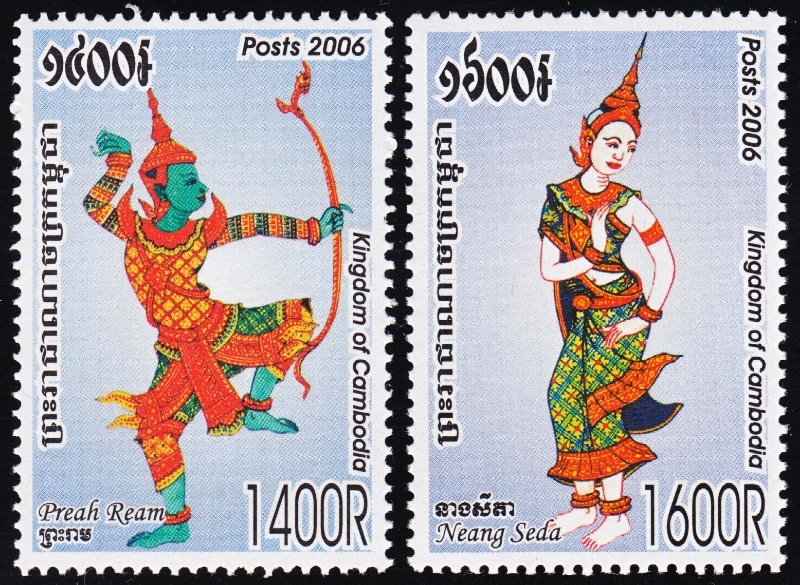
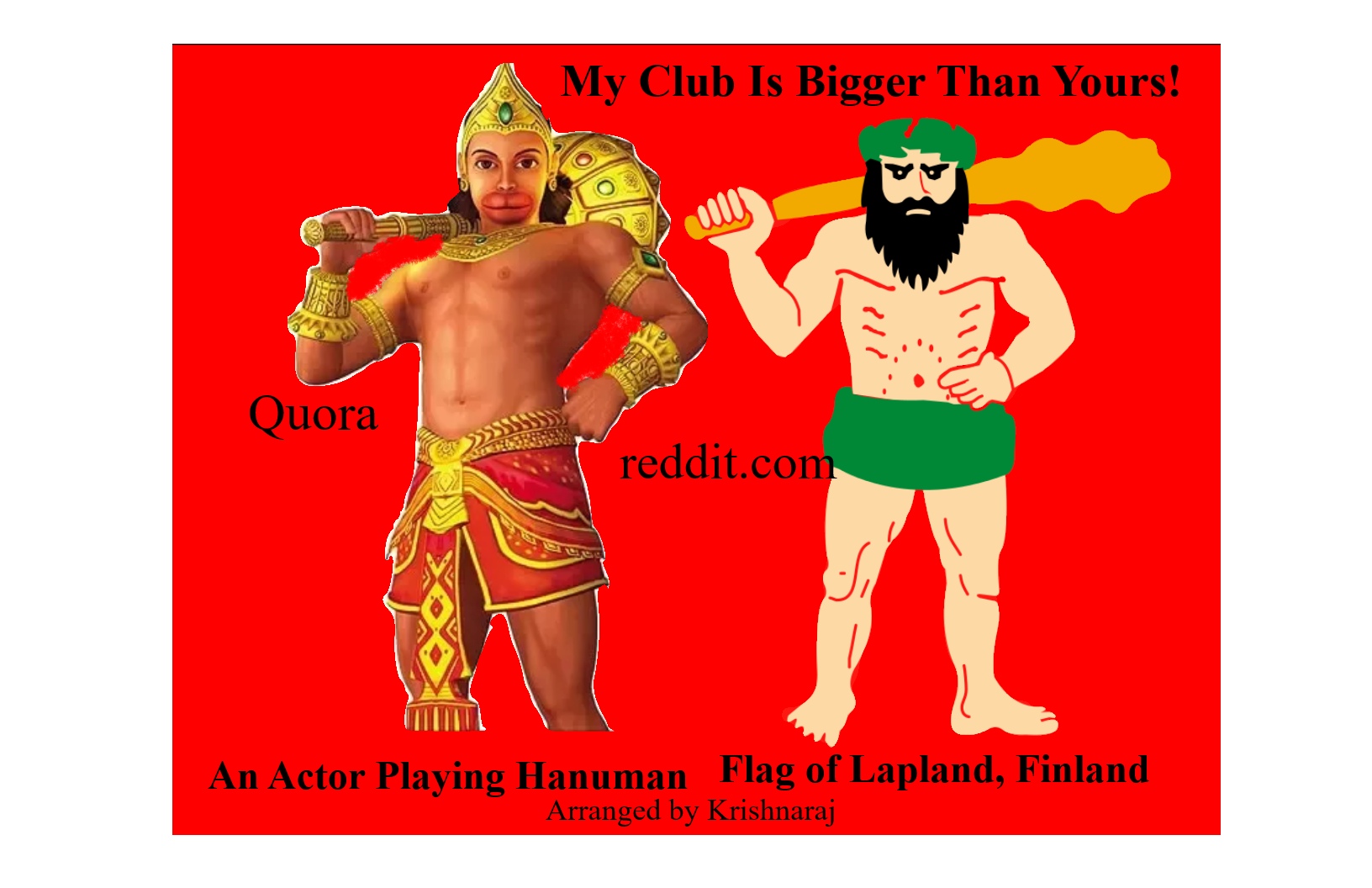
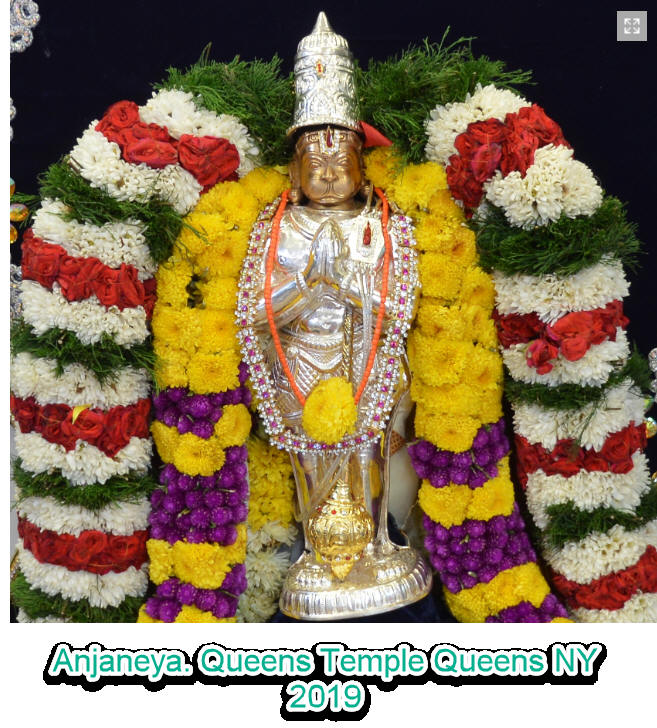

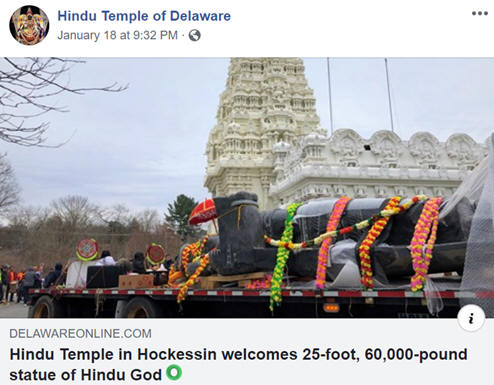
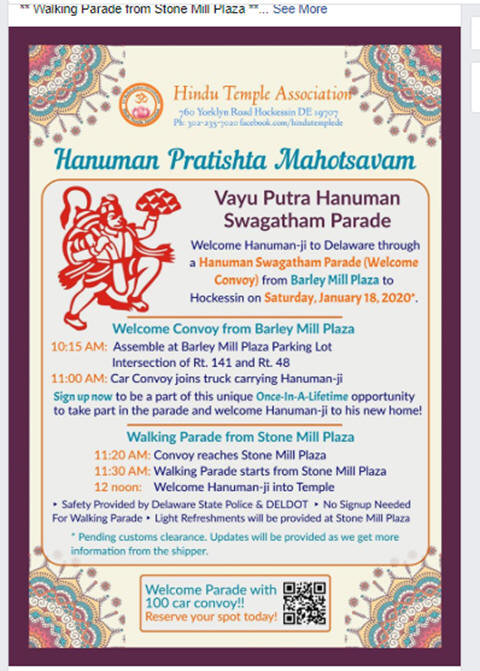
The Story of Cotton. Who Picked the Cotton First? Connection between Hanuman & Cotton.
February 16, 2020
It all started in the heavens. But for that, we would not have cotton.
The gods in the Indra's heaven were running around naked. Then came the luxury of wearing the tree barks, which they used to conceal their assets immediately below the navel. Indra once threw a lavish dinner and invited the gods. The cynosure of their eyes was the sinuous Sachi, the wife of Indra, who danced and pirouetted on the stage. It was such a vigorous dance; the bark around her waist fell suddenly. The eyes widened, and the mouths gaped. The gods and Indra sat there, shocked to witness a wardrobe malfunction. They wondered aloud as to how to prevent such a failure. They all went to the four-headed Brahma, the knower of Vedas for a solution. He put his four heads together but could not come up with a solution. They went to Vishnu reclining on the coiled bed of a snake with Lakshmi massaging his feet. They wanted a dress that will sit tight on the hips, gravity-proof, light in weight, and elegant. No answer was coming forth.
(This Sachi episode happened before Adam and Eve strutted around with fig leaves around 4004 B.C.)
Then they all gravitated towards Siva, the ash-wearer. Siva gave a thought to it and turned to Parvati for advice. After consultation with Parvati, Siva raised a fire from which a man jumped out. His name was Siva Dasa. Siva ordered Siva Dasa to prepare clothes for Sachi.
Cotton was unheard of in those days. They never had cotton clothes. Siva Dasa sought Hanuman's help. Hanuman's task was to bring in the eight fiery eyes of a mountain-dwelling titan named Kalpasura. When the gods planted the eyes, they grew into cotton trees with cotton pods. Hanuman fetched the eight eyes, lost three eyes, and placed reverentially before Siva and Bhavani five eyes. They sowed the ground with eye-seeds, and the cotton trees sprang from the fertile soil.
Siva, Bhavani, the gods, Hanuman and Siva Dasa, asked Visvakarma to make clothes with the cotton fibers. Visvakarma put his nose to the grindstone and created looms, weaving machines, the whole shebang, and the whole nine yards to develop an article of clothing for Sachi. He presented the jig to Siva and Bhavani.
Siva Dasa went to work to make clothes. Brahma, at the urging of Siva, created Kusavati from a blade of Kusa grass to be the wife of Siva Dasa and a fellow worker designing and making clothes. He made clothes for gods and others. Kusavati and Siva Dasa had four sons: Balarama, Uddhava, Purandara, and Madhukara. The weavers of today are his descendants.
This cotton story was before Manu came into the picture and divided the people into four divisions. Manu put the weavers in the Vaisya category. The weavers and tailors for the gods and people became the victims of relegation to third place in the totem pole. They were the Tantuvayas with four sub-castes. End of text by Veeraswamy Krishnaraj
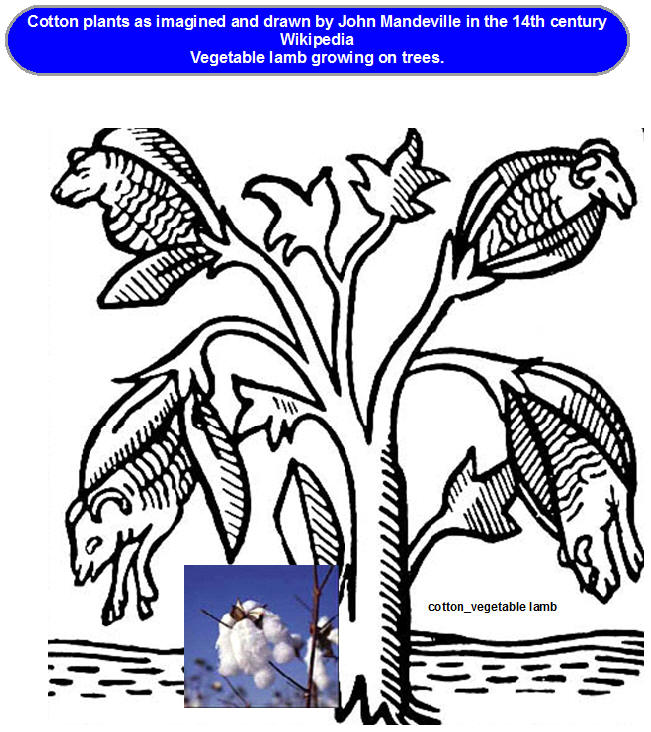
During the late medieval period, cotton became known as an imported fiber in northern Europe, with no knowledge of how it was derived, other than that it was a plant. --Wikipedia
Mesopotamians imported cotton, chicken, precious metals and stones from India, and obviously kept the secret.
Ramba, an apsaras, was a heavenly beauty even the poets could not find words to describe her physical charms. She was on her way to a festival and met Ravana, who did not know who she was. She introduced herself as the wife of Ravana's nephew Nalakubara, a relationship akin to a niece or a daughter-in-law. Ravana said to her he did not consider her as the wife of any man because she was an apsaras. Ravana forced himself on her, though she resisted. When he let her go, her hair and clothes were in disarray. Her jewelry was scattered. She trembled like a leaf in a wind-swept tree. When she went home and told her husband all that happened, he consoled her and laid a curse on Ravana that if he ever forced himself upon an unloving and unwilling woman, his head would split into several pieces. Reference: Harper's Dictionary of Hinduism, Page 247 by Margaret and James Stutley.
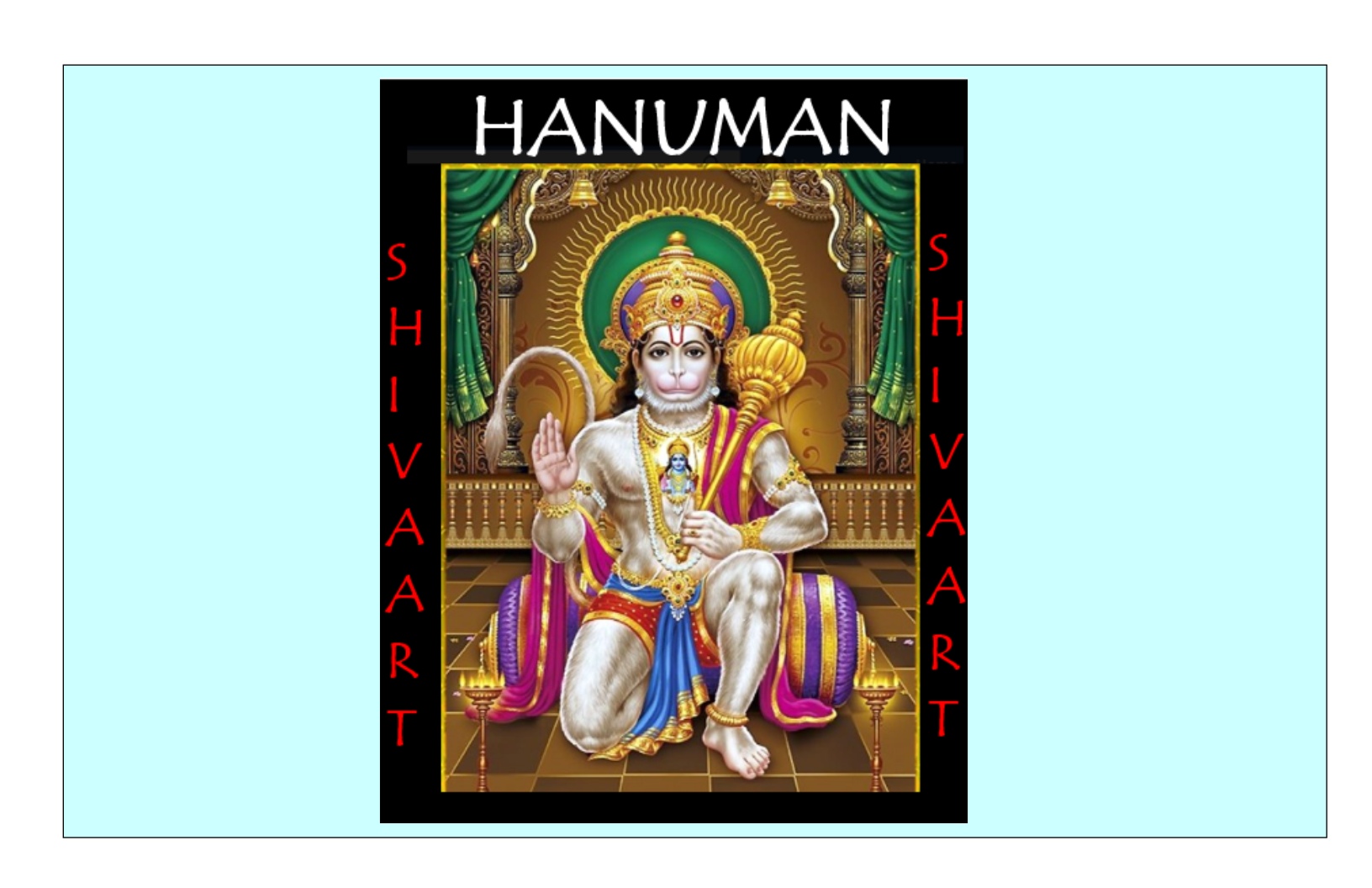
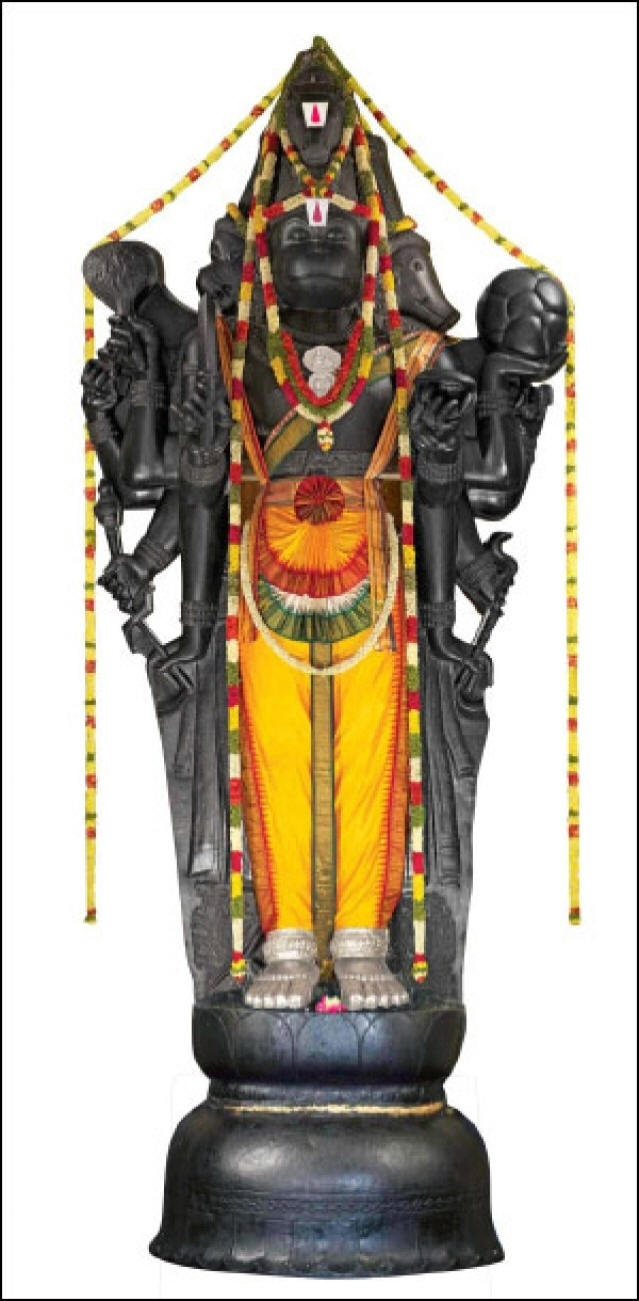
Pañchavadi Pañchamuka Āñjanēyar Temple in Puducherry (May 14, 2020)
All that begins well with Ganesha ends well with Hanuman. These two deities are beyond the reach of malefic effects of the planets, and the same privilege extends to their devotees. Utter Ramanamam, and before you finish it, Añjanēyar is there to confer grace and protection along with mental solace, auspiciousness and good fortune to the chanter. Hanuman likes the self-effacing devotee.
Puducherry Pañchavadi Pañchamuka Āñjanēyar Temple
Panchavatee Jayamangala Panchamukha Sri Anjaneyaswamy (பஞ்சவடீ ஜெயமங்கள பஞ்சமுக ஸ்ரீ அஞ்சனேயஸ்வாமி)
Pañchavadi is the village where the temple exists. Pañchamuka means ‘five-faced.’
Pañchavadi means a forest with five kinds of trees: Arasu, Āl, Vilvam, Nelli, and Asōkam.
அரச மரம், Ficus religiosa
ஆலமரம், Ficus benghalensis
வில்வம், Bael tree, Aegle marmelos
நெல்லி, Emblica officinalis
அசோகமரம் Ashoka tree or Saraca asoca
The events that led to the creation of Pañchamuka Āñjanēyar.
Mayilravanan (brother/cousin of Ravanan) stole the Sudarsana Chakra of Perumal and Ramar asked Hanuman to retrieve it. A fierce battle ensued between the two. Unable to face the fury of fierce Hanuman, Mayilravanan planned to vanquish Hanuman by trickery. Ramar seeing the ferocity of Mayilravanan, advised Hanuman to take the form of an animal, bird or snake to kill the demon, who might morph into animal forms. With Ramar's blessing Hanuman took the combined forms of his earlier incarnations: Varaha, Narasimha, Hyagriva and Garuda. Thus Hanuman morphed into Pañchamuka Āñjanēyar, the five-faced Hanuman with a third eye on each.
In the Rāma-Ravana Mahābhārata war, Ravana was on the cusp of losing the battle against Rāma. To save him from imminent death, `Ravana’s brother/cousin Mayliravanan performed Yāgam.'
Who is this character, Mayilravanan? He is the sibling or the cousin of Ravana, also known as Ahiravanan. He abducted Rama and Lakshmana to the Netherworld and hid them for sacrifice to Chandi. He had a brother named Mahiravanan; these two brothers ruled the Netherworld. You may ask why Rāma being God did not prevent his own abduction. The answer is to prove the extraordinary presence of Hanuman to do the impossible.
If the malefic Yāgam came to a successful conclusion, RāmaLakshmanars would die, and Ravanan would live. Ānjanēyar prevented the Yāgam from going farward. He assumed the form of Pañchamuka Āñjanēyar, grew to a height of 36 feet, shone brightly and put an end to it.
Pañchamuka Āñjanēyar with blessings from Rāmapirāṉ paid homage to Narasimhar, Varākar, Garudā, and Hyagrīvar and received their blessings. They not only gave their inherent powers to him but also blessed him with their five analog faces. That was why he was so powerful. His temple exists in Pañchavadi on the highway between Tindivanam and Pondicherry. The only way to kill Mayilravanan is to blow out five lights placed in different directions simultaneously in the palace of Mayilravanan. Hanuman poised the five heads in such a way the individual heads faced the lights. Hanuman blew out the lights with one puff from each head simultaneously. Mayilravanan's death was instant. Hanuman sprang RāmaLakshmanars from the prison, installed his son Makaradhwaja as the king of the underworld. Ānjanēyar carried RāmaLakshmanars out of the Netherworld on his powerful shoulders.
In this temple, Rāmar, Sīta, Lakshmaṇa, Satrugṉa, and Bharata are under one roof in the sanctum sanctorum, protecting and offering grace to the devotees. Śrī Rāmar’s footwear is the holy exhibit offering Darsan to the devotees. The five deities that make up the five faces of Āñjanēya individually grant grace and benefits: Success in endeavors by Narasimhar, Grace by side glance by Lakshmi, intellectual and spiritual endowment by Hayagrīva, mental strength by Varāhar and immunity from poisons, mental repose, and auspiciousness from Garuda. Āñjanēya’s face is anterior. The cluster of heads is those of Varaha, Garuda, Anjaneya, Narasimha, and Hayagrīva."
This pentad has auspicious significance. Circumambulate Āñjanēyar 5, 14, 23, 32, 41, 50, or any number of times. The number or numbers should be or add up to 5, for example, 23 (2+3 = 5). That is the auspicious number five.
Āñjanēyar is the most prolific giver of boons, nullifies all our hardships, and extends grace.
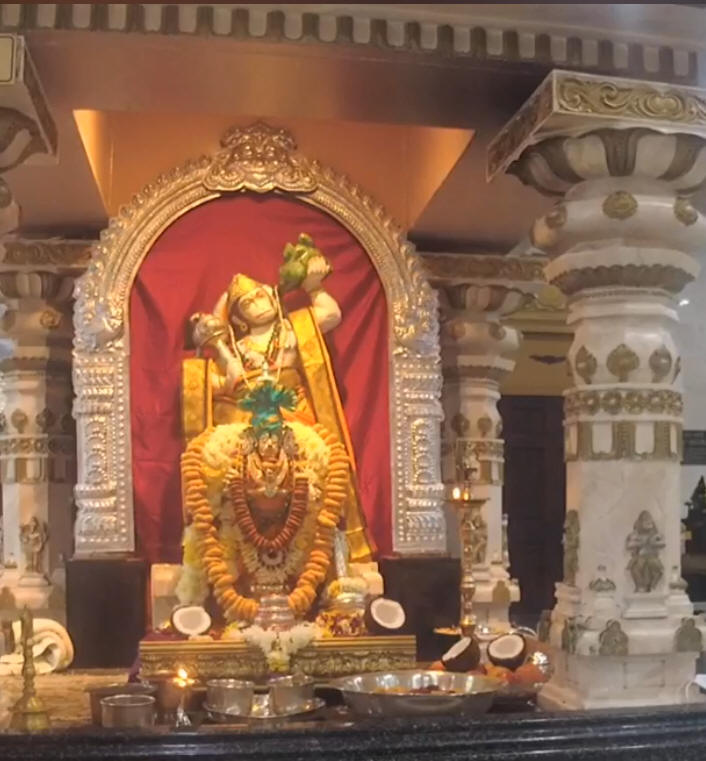
Hanuman in the Balaji Temple, Bridgwater New Jersey USA Photo by the Temple (Facebook) on May 16, 2020
Āñjanēyar in a Wedded Bliss. June 3, 2020
Did you have a secret desire to marry your professor's daughter? Nothing wrong with it. Take Hanuman. He married his professor's daughter. One lucky guy. Now read the story.
Āñjanēyar
had this desire to study under the tutelage of Sun God. The Sun God
accepted him as his pupil, knowing of his usefulness in bringing relief
to people. He placed a condition before accepting him as a
student.
The Sun God said to Āñjanēyar, “I cannot stop
the Sun Chariot even for a nanosecond and will instruct you only face to
face.
Since when a student had a face to face instructions with his professor until the end of the course? This solar professor was blindingly bright. Face to Face with the sun. Get my Ray-Ban
Āñjanēyar accepted the condition, jumped on the
orb of the Sun, faced the Sun, ran backward, and learned his lessons.
Though Sūrya Bhagavāṉ felt compassionate towards his pupil, he could not stop the Sun Chariot because of fear of harming millions of life forms.
The Sun God Gave Hanuman education in arts,
music, and the Vedas.
Hanuman had one pressing desire to earn the
title, “Navavyākaraṇa Pundit.” The stipulation for one Vyākaraṇa was
that the applicant should be a married person. Therefore, Hanuman must
get married. Navavyākaraṇa = The nine ancient treatises on
Sanskrit grammar.
Where is Hanuman going to find a wife in short
order? He was in a pickle.
Sūrya Bhagavan came to his rescue and said,
“Dear Hanuman, would you marry my daughter, Svarcchalādēvi? Soon after
your wedding to my daughter, you may begin your courses in
Vyākaraṇās. Hanuman jumped for joy. They were married. His studies began
right earnest and Hanuman earned his title, “Navavyākaraṇa Pundit.”
Hanuman has the wedded look in Śrīkalyāṇa
Āñjanēyar Temple in Thailavaram. His name is Śrījeyavīra Āñjanēyar, an
eight-foot-tall fixed deity in the sanctum. In a separate shrine, he
appears as the processional deity with Svarcchalādēvi on a lotus flower
base. He has four hands holding a conch and a discus. His devotees enjoy
receiving his Darsan.
Thus the Sun God became his father-in-law.
Bachelors and maidens. Just be cool; Be a
sincere devotee of Hanuman. Apply a Vada-Malai. You are assured of a
wedding.
Would you invite a mortal enemy to perform sacerdotal services? That happened in one episode in Ramayana.
The Vanaras built the Rama Setu. The bridge was spick and span. They screeched, scratched, bared their teeth, flipped in somersaults, and slapped their palms in high-fives. Sugriva, Anjaneya, and the generals suddenly stood up. The Vanaras blinked their eyes and looked around. Behold! There was Rama. The slapstick came to an abrupt halt. All the Vanaras lined up in rank and file—such discipline among them. Ramar's face glowed in divine splendor, and he expressed his gratitude to all of them.
Ramar addressed Jambavan that he wanted to dedicate the new bridge by performing Siva Puja. Jambavan was attentive. He knew he had a problem. There was no Pandit in the neighborhood to perform the Puja. Get one somehow; they must—no ifs and buts, and no when and wherefrom. Find one at any cost. An idea struck Jambavan like a thunderbolt. He thought first: No, it shouldn't be. Blasphemous. A tremor seized him. He composed himself and said to Ramar the unutterable word, "Ravana." Ramar's face did not flinch or twist. He was a greater man for that. He was divine. Seeing Ramar calm and composed at Jambavan's suggestion of Ravana as the high priest, Hanuman thought here was an opportunity to serve Rama again. Ramar read his mind. "You must be on your way. Get with it please." Ramar told Jambavan to send Hanuman on the mission. Sugriva and the Vanaras wondered and sorrowed that a mortal enemy Ravana should be the priest to perform the bridge opening ceremony.
Hanuman was more than ready. Who could stop him when Ramar himself asked him to serve as the envoy to Ravana?
The Arakkars were looking at the newcomer in the Assembly Hall. Hanuman was in Ravana's Assembly Hall. Does he not look familiar? Yes, he is the heartache. He set fire to our city. They all converged on him, wanting to tear him into pieces and cast him to the vultures and crows. Hanuman stopped them dead in their tracks by yelling, "Peace-Peace. I came seeking the priestly services of Ravana, the foremost among the Siva Bhaktas." That rang a collective alarm bell in the hearts and minds of Ravana himself and the Assembly members. Could this be a diversion, a trick, a deception, or a conspiracy? It shook their core individually.
Hanuman's body language assuaged their infernal fear and he stated to them the goals of his mission. Ravana signaled to the Assembly with his hands to calm down. Ravana agreed to the proposal and offered to dedicate the bridge, being the polymath of the Vedas and sacred texts. How could such an erudite scholar and Siva Bhakta descend to such a low level of abducting Mother Sita?
Ravana saw Rama, Sugriva, and the Vanara army. An inkling perhaps of the things to come.
Rama came forward and imploringly asked him whether everything he saw was adequate for the Siva Puja. Ravana, for a moment, was in deep thought. He found something amiss. He told Rama that he could do Puja only for a couple and not for a singleton. Ramar implored the Puja must proceed. Ravana had the answer up his sleeve. He would bring Sita to stand by Rama for the Siva Puja, that no conversation could transpire between them and that Sita would leave the spot soon after the Puja. Ramar kept quiet, indicating his concurrence.
Then Ramar spoke, "What about the Dhakshina for your services." Ravana uttered to Rama almost in a soliloquy so no one could hear, "I am grateful you regarded me as a worthy Pandit to perform the Siva Puja. I thank you for it. I do not charge sacerdotal fees for the Siva Puja. If in case my life is ebbing in the battlefield, you must stand by me. That act of yours will be my fees."
